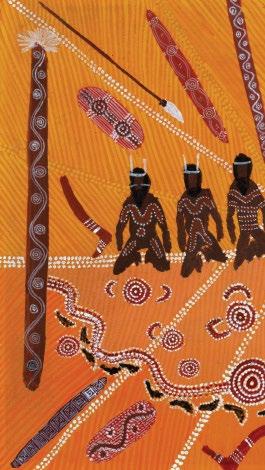






Founding Director - Senior Specialist
adrian@cooeeart.com.au | +61 412 126 645
A former President of the Indigenous Art Trade Association and Director of Aboriginal Tourism Australia, Adrian established the Aboriginal art department for Lawson~Menzies in 2003, later acting as Managing Director of Menzies Art Brands, which under his stewardship, became the market leader. The former President of the Art Consulting Association of Australia, Adrian curated Cooee Art Auctions’ first specialised sale in 2017. For more than 40 years Adrian has been a passionate advocate for Australian Indigenous and contemporary art and has written widely for books, art publications and newspapers.
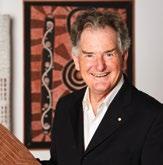
emma@cooeeart.com.au
Educated in Fine Art at RMIT, Emma joined Cooee Art in 2016 as the Paddington Gallery Manager. In 2019, she became the Auction Specialist for Cooee Art Auctions. With a long history of employment in the arts, including positions at international institutions, commercial galleries, and private collections. Emma has an uncanny ability to match keen collectors with their ideal artworks. Her extensive knowledge of Australian Indigenous art positions her as ideal bridge between sellers and buyers.



mirri@cooeeart.com.au | +61 416 379 691
Mirri joined Cooee Art in 2007. After extensive travel following her double degree in International Development and Fine Arts, and Masters degree in Art Administration from the UNSW College of Fine Art. In 2016, she became the CEO and co-owner of the company, spearheading the opening of Cooee Ar t’s Paddington gallery, and developing Cooee’s gallery program and the launch of its Auction wing in 2017. A board member of the Aboriginal Art Association of Australia, Mirri initiated and drove the move into Cooee Art’s vast Redfern Gallery and auction rooms in early 2021.
auction@cooeeart.com.au
After living in London, Tokyo, Paris, and Tel Aviv, Mia studied at the University of Sydney in Art History and Economics. Following her passion for culture and art history, she was a decorative arts specialist at Shapiro Auctioneers in Woollahra, before joining Cooee Art’s auction department. Mia brings both creativity and practicality to her role as Auction Administrator.
The son of an artist and art critic, Sam has worked in galleries across Berlin and Sydney, including his first job at the legendary Galerie Eigen + Art in Berlin from the age of 13. Prior to joining Cooee Art, he worked at the legendary Ray Hughes Gallery in Sydney, which he managed in its final years before opening his own, The New Standard Gallery, which ran from 2016 to 2018. Sam now acts as Cooee Art’s Art Handler.

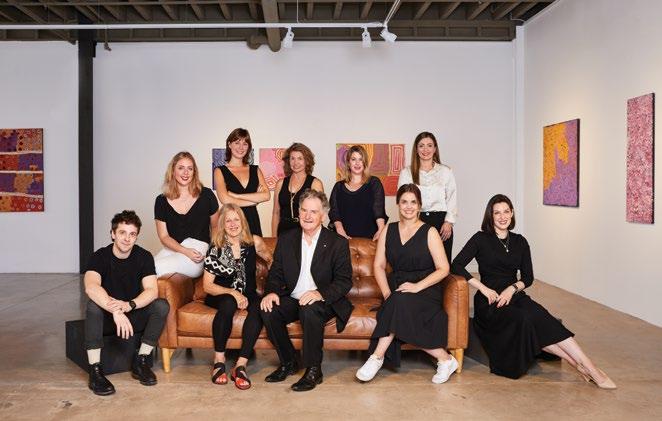
Renata has a Bachelor of Fine Arts from the University of Tasmania, with a major in Graphic Design, and a Masters in Art Curatorship from the University of Sydney. Over the past decade, she has helped facilitate over 100 exhibitions nationally and internationally, and worked for a variety of commercial galleries, artist run initiatives, art festivals, and major art institutions, most notably the Museum of Contemporary Art. Renata first joined Cooee Art in 2011, returning in 2018 as their Digital Content Curator.

Each year, as we view private collections here and overseas in the hope of securing important early artefacts and artworks for our Cooee Art Auctions, we uncover artworks created during the past century that surprise and delight me. Seldom more so than on this occasion.
The two early boards in this sale are as good as they get. Foremost, is the very first painting ever credited to Clifford Possum Tjapaltjarri – Untitled, Possum Dreaming c.1971 (Lot 27) is considered by many to be a vital part of the National Estate. According to Wally Caruana, the former curator of Aboriginal art at the National Gallery of Australia,‘this small yet luminous work emanates a numinous quality’, while anthropologist John Kean has commented that it reveals ‘an encyclopaedic representation of objects that refer to its restricted ceremonial context’. Dr.Vivien Johnson, the artist’s biographer, has argued that it is ‘vital for the early history of Papunya painting, arguably Australia’s most significant art movement, that this work be retained here in Australia, if possible in a public collection’. The board carries an estimate of $150,000 - $180,000.
The sale also features one of the earliest paintings by Papunya master Mick Namarari who’s sheer variety of subjects and diversity of stylistic approaches kept him at the forefront of Western Desert painting for almost three decades. Dingo Ceremony, 1972 (Lot 26) was created at the dawn of the Western Desert painting movement. Namarari depicted a ceremonial hairpiece and dance boards inscribed with a fascinating array of markings relating to the travels of the ancestral dingo, estimated at $80,000 - $100,000.
Works by Emily Kame Kngwarreye feature strongly, as befits an artist who has scaled the lofty heights of the international art world during the past decade. Paintings in this auction, range from one of her earliest works, Untitled, 1989 (Lot 10 Estimate $25,000 - $35,000) which featured in the Queensland Art Gallery retrospective in 1998, to a vivacious action painting entitled Alatyite (Spinifex Dreaming) created for Utopia Art in 1994 (Lot 57 Estimate $80,000 - $120,000). A highlight of the auction, (Lot 39 $80,000 - $120,000) Yam Dreaming, 1995 is a striking example of her black and white Yam works that were created for the Holt family at Delmore Downs, the largest of which holds pride of place in the collection of the National Gallery of Victoria (Big Yam Dreaming, 1995).
The sale includes two magnificent large paintings by iconic Western Desert artists. Naata Nungurrayi’s 182 x 242 cm masterpiece, Marrapinti, 2009 (Lot 46) carries a presale
estimate of $150,000 - $220,000. Warlimpirrnga Tjapaltjarri’s exquisite tour de force, Maruwa, 2016 (Lot 40), measures 200 x 300 cm and is estimated at $100,000 - $140,000.
Amongst the 103 items in this sale, I would be remiss in not pointing out the rare and delightful painting on slate by Charlie Numbulmoore, Wandjina created in the early 1970s (Lot 23 Estimate $25,000 - $30,000), and the delicate and beautiful desert landscape on beanwood Mount Sonder by Albert Namatjira painted in 1947 (Lot 8 Estimated at $30,000 - $40,000).
Large captivating artworks from the Aṉangu Pitjantjatjara Yankunytjatjara (APY) Lands have been a feature of major landscape prizes in recent years – we have several wonderful examples in this offering.
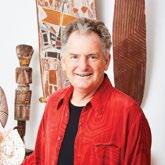
It has been a great pleasure putting this lovely collection of works together. I hope you find that special piece amongst them that speaks irresistibly to you.
Founding Director - Senior Specialist
Albert Namatjira
Alma Webou
Artist Once Known
Bill Tjapaltjarri Whiskey
Boxer Milner
Brook Andrew
Carrolup Children of South West WA
Charlie Numbulmoore
Charlie Taruwa Tjungurrayi
Clifford Possum Tjapaltjarri
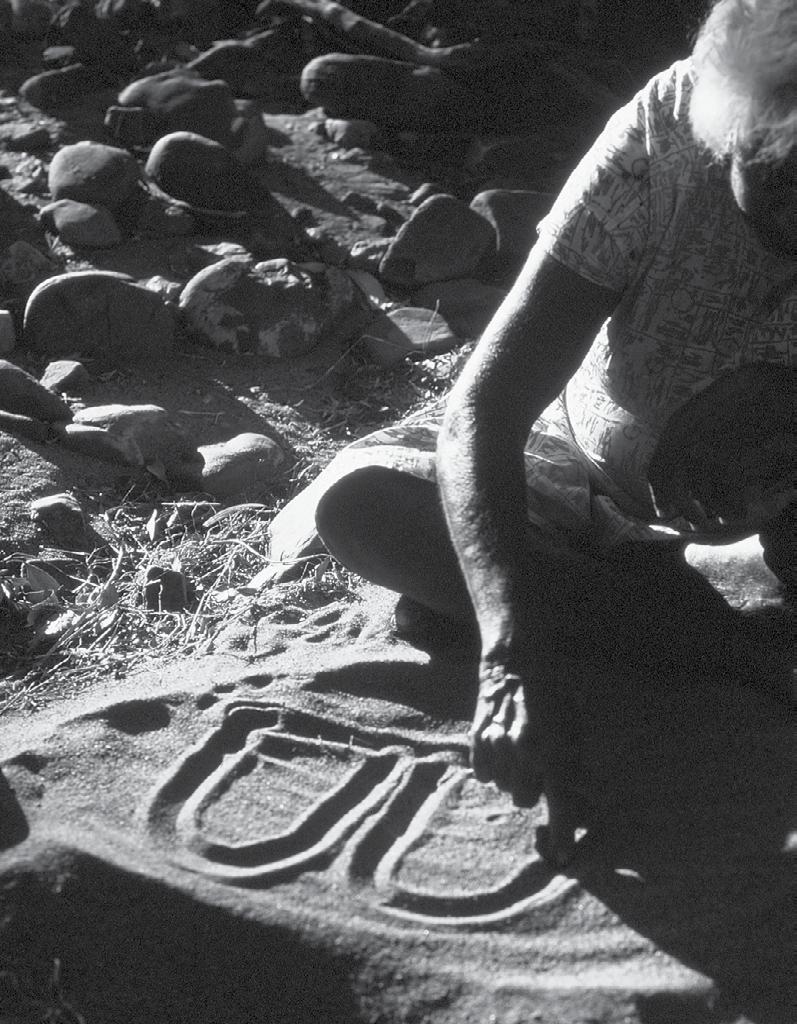
Cory Wakartu Surprise
Datjirri Wunuŋgmurra 2
Destiny Deacon
Dickie Minyintiri
Dorothy Robinson Napangardi
Elizabeth Nyumi Nungurrayi
Emily Kame Kngwarreye
Eubena Nampitjin
Freddie Timms
George Milpurrurru
George Ward Tjungarrayi
Gloria Petyarre
Gunybi Ganambarr
Jack Britten
Jack Djiwul Wunuwun
Jack Mengenen Dale
Jan Billycan
Jean Baptiste Apuatimi
Jimmy Nerrimah Mawukura (Mulgra)
John Kipara Tjakamarra
John Mawurndjul
Johnny Mosquito Tjapangarti
Johnny Warangkula Tjupurrula
Johnny Yungut Tjupurrula
Judy Napangardi Watson
Julie Nangala Robertson
Keith Stevens
Kitty Kantilla
Kudditji Kngwarreye
Lin Onus
Lorna Naparrula Fencer
Makinti Napanangka
Mick Namarari Tjapaltjarri
Minnie Pwerle
Mirdidingkingathi Juwarnda Sally Gabori
Naata Nungurrayi
Ningura Napurrula
Nyurapayia Nampitjinpa (Mrs Bennett)
P. Ngal
Paddy Wainburranga Fordham
94 8 87 66, 73, 74, 75,76 11 72 14 99, 100 23 83 27 69 34 15 79, 82 37, 93 56, 71 7, 10, 39, 50, 55, 57 70 21, 25 32 31 38 35 22 33 20 88, 98 67 80 84 12 18 63 97 86 92 89 68 85, 90 1, 16 58 3 26 5, 36, 53, 101 6, 102 42, 46 47 48, 64 54 77
Paddy Jampin Jaminji
Patrick Oloodoodi Tjungurrayi
Patsy Anguburra Lulpunda
Peg Leg Tjampitjinpa
Prince of Wales
Queenie McKenzie Nakara
Regina Wilson
Richard Bell
Ronnie Tjampitjinpa
Rover Thomas Joolama
Tiger Palpatja
Tiger Yaltangki
Timmy Payungka Tjapangati
Tjumpo Tjapanangka
Turkey Tolson Tjupurrula
Various Artists
Walala Tjapaltjarri
Warlimpirrnga Tjapaltjarri
Weaver Jack
Yannima Tommy Watson Yaritji Heffernan
24 61 19, 103 78 2 9, 49 51 4 28, 30 13 96 60 91 81 41 17, 43, 95 62 29, 40, 65 59 45, 52 44
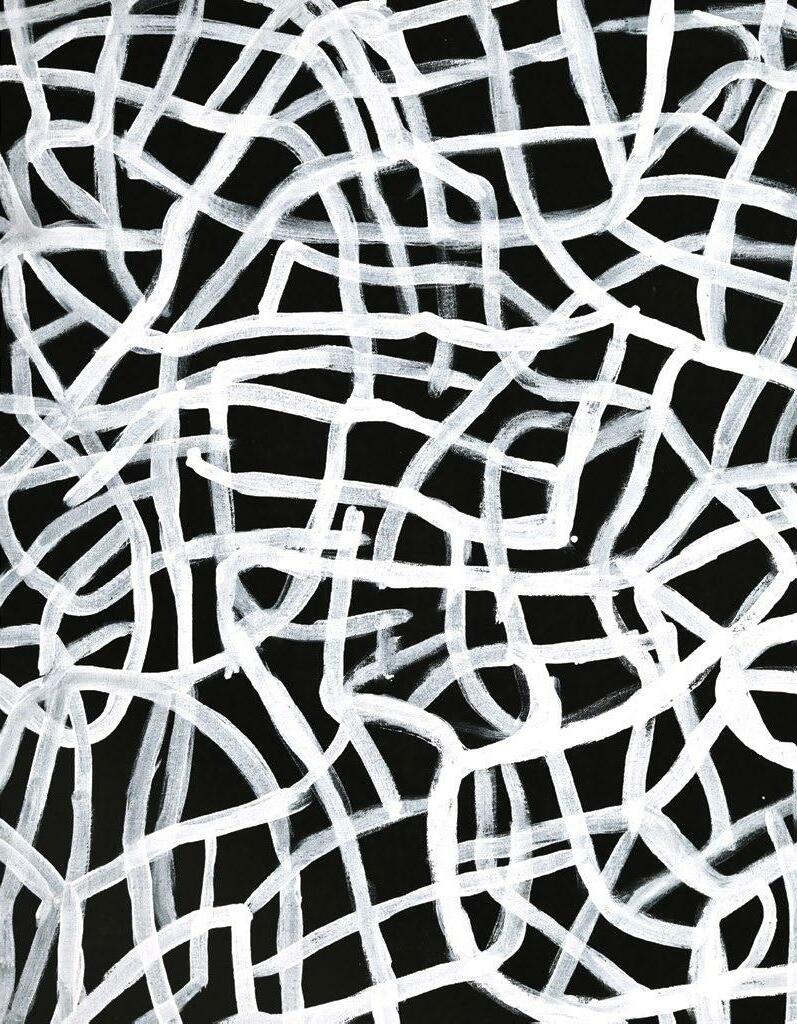
MICHAEL AND I ARE
x
LIN ONUS
x
-
(framed)
Artist’s Estate, Vic Private Collection, Vic
Signed below image
Lin Onus, Urban Dingo: The Art and Life of Lin Onus 1948-1996, Craftman House, 2000, front cover
This iconic image was part of the series of works entitled ‘The Ongoing Adventures of X and Ray’. This was begun in 1992, and like all good myths, has continued its adventures after Onus’s death under the custodianship of his son Tiriki and collaborator Michael Eather.
In this work, inspired by a residency in Yokohama in 1989, the two totemic animals perform social, moral, and political roles as they travel the places where Lin has been, or inhabit fictionalised landscapes.
This seminal work reveals both a kinship between these two travellers and the importance of the narrative and humour.
X (the male dingo ) and Ray (the female Stingray) are seen riding the crest of one of art history’s greatest waves, taken from the eighteenth century Japanese woodcut by Hokusai.
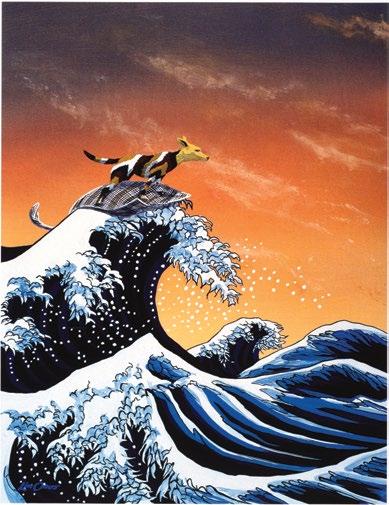
BODY MARKS, 1998 76 x 56 cm; 90 x 69.5 cm (framed) synthetic polymer paint and water colour on paper
$3,000 - 5,000
Accompanied by a certificate of authenticity from Karen Brown Fine Art
Born with the tribal name Midpul, Prince of Wales grew up with his mother’s people, the Wadgigiyn, on the Cox Peninsula across the harbour from Darwin. He spent much of his adult life living at the beach camp at Cullen Bay, now an expensive marina development. His father, Imabul, was known as King George and this, perhaps as much as the fact that Midpul danced for Queen Elizabeth during a royal trip to Australia in the 1960s, resulted in his familiar ‘English’ name.
Despite suffering a stroke prior to gaining fame as an artist, Prince of Wales was the first contemporary Aboriginal artist from the Larrakia region to gain wide renown. He painted the traditional body designs used in Danggalaba ceremonies, a subject with specific sacred cultural content.
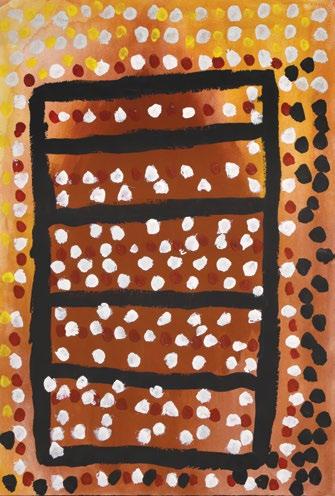
MAKINTI NAPANANGKA (c. 1930 - 2011)
WOMEN’S HAIR-STING, 2003 91 x 61.5 cm
synthetic polymer paint on Belgian linen
EST $5,000 - 7,000
Papunya Tula Artists, NT, Cat No. MN0310198 Private Collection, SA
Accompanied by a certificate of authenticity from Papunya Tula Artists
Makinti began painting in 1994, when a women’s painting project was organised for the Haasts Bluff and Kintore communities. Her gestural style and bold line work were derived from painting with her fingers dipped in earth ochres onto women’s bodies for ceremony. The tactile surfaces of her paintings reflect this touching and sensing, while the images serve to revive the journeying of her two female ancestors, the Kungka Kutjarra, as they dance their way across the country. Their travels follow the desert water sources and, particularly in Makinti’s art, Lupulnga, the rockhole where she was born, and where her connections to her spiritual origins are felt. “Care for country” is an important motivation for this bond, as the water sources must be cleared of debris and sand to keep them, and the life they support, fresh and flowing.
The lines throughout the work invoke the body painting for women’s ceremonies and more particularly represent spun hair-string, which is used to make belts worn by women during ceremonies associated with this Rockhole site.
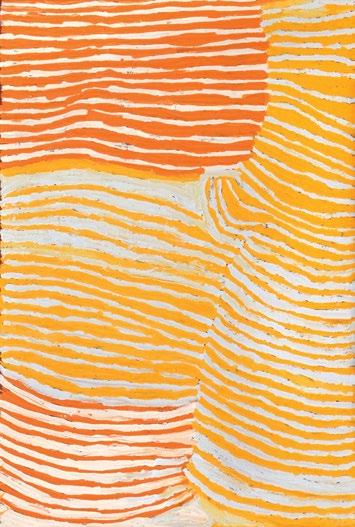
Born in 1953, Richard Bell spent his early childhood living in a tent, then a corrugated tin shack on an Aboriginal reserve until he was 14. He witnessed firsthand the mistreatment of Aboriginal people when his home was bulldozed by the government. He became involved in the Aboriginal Rights Movement in the 1970s before working for the New South Wales Aboriginal Legal Service, and began painting at 34 as a way to earn money by making souvenirs for tourists.
Presented as a single lot, both works were created the year before Bell won the Telstra National Aboriginal & Torres Strait Islander Art Award with his work ‘Scientia e metaphysica (Bell’s Theorem)’. These works are described by Bell as colour field studies arranged ‘like liquorice all-sorts, overlaid with sprays of Pollocktype paint’.
Bell plays with the appropriation of abstract expressionism and works by pop art painters like Roy Lichtenstein, Jasper Johns, and Andy Warhol. The text that accompanies each piece challenges the viewer, exposing Australia’s racism towards Aboriginal people, endemic white privilege, negative stereotyping, and exoticising of the “other”.
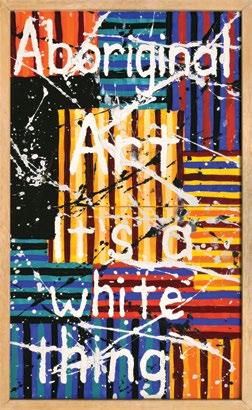
his introductory North American exhibition, Richard Bell: I Am Not Sorry, showcased in New York.

5
MINNIE PWERLE (1910 - 2006)
AWELYE ATNWENGERRP, 2004 91 x 117.5 cm; 94 x 120 cm (framed) synthetic polymer paint on canvas
EST $10,000 - 15,000
Dacou Gallery, SA, Cat No. DG05483
Flinders Lane Gallery, Vic, Cat No. FG04022 Private Collection, Vic
Accompanied by a certificate of authenticity from Flinders Lane Gallery and an image of the artist with the completed work
Minnie Pwerle began painting depictions of her country, Atnwengerrp, and its Dreamings when in her late 70s. The manner in which she created her works appeared to be the result of an urgency to reconnect to the past and to keep the Dreaming a living reality.
Minnie’s primary focus was the Bush Melon and its seeds. Her AwelyeAntnwengerrp paintings drew directly from these ceremonial practices, depicting bush melon, seed, and breast designs. The energy of these vibrant colourful works seemed to capture the joy of coming across these sweet bush foods, now scarce and difficult to find.
The bold linear patterns of stripes and curves throughout Minnie’s paintings depict the women’s ceremonial body paint design. After smearing their bodies with animal fat, the women trace these designs onto their breasts, arms and thighs singing as each woman has a turn to be ‘painted up’.

Mornington Island Arts and Crafts, NT, Cat No. 1689-L-SG-1006 Merenda Gallery, WA, Cat No. MG139 Private Collection, WA
Accompanied by a certificate of authenticity from Mornington Island Arts and Crafts
Sally Gabori first picked up a paintbrush in 2005 at 81 years of age. The Lardil people in the Kaiadilt community had little exposure to fine art, or any comparable form of mark-making prior to that time. Traditional tools, objects, or bodies were scarcely painted, and the only recorded art that relates these stories was a group of drawings made at the request of ethnologist Norman B. Tindale during his expedition to Bentinck Island in 1960, now housed in the South Australian Museum.
Her paintings are essentially concerned with meaningful sites, known through the artist’s intimate association during a lifetime spent on Bentinck Island. These sites are associated with tidal movement, seasonal change, major climatic events such as drought, and flood, and the presence of plants, sea birds, animals, and aquatic life. Gabori was mindful of the ebb and flow of life over all the seasons that made up her long life. As Djon Mundine eloquently put it. ‘Her works can be thought of as a memory walk, and a mapping of her physical and social memory of Bentinck Island’.*
Djon Mundine, The Road to Bentinck Island: Sally Gabori, in The Corrigan Collection of Paintings by Sally Gabori, Macmillan Art Publishing, Melbourne, 2015
YAM
Delmore Gallery, NT, Cat No. 93D0/2 The Thomas Vroom Collection, The Netherlands Private Collection, Vic

Reflected in this work is the Anooralya Yam, the most important plant in Emily’s custodianship. This hardy and fertile plant provides both a tuber vegetable and a seed bearing flower called Kame (Emily’s tribal name). The visual evidence of maturing species is no cause for alarm in terms of survival, for the yam tuber can always be found where cracks in the earth’s surface indicate its presence underground.
Such application of green, pink, and brown colours highlights the varied and changing hues in the life cycle of the Anooralya Yam, and other food plants found near Alalgura on Utopia Station. From an aerial perspective, we see sporadic clustered growth after summer rain. We also look at this exciting work as a water catchment area. The rain falls and water slowly flows along the broad shallow watercourse and replenishes the soakage at Alalgura. The flourish of growth that follows is exceptional and rapid.
Acquired directly from the artist, 1948, WA
Thence by decent, WA Private Collection, WA
Accompanied by a letter written in 1964 by the son of the acquirer
Signed lower right
Albert Namatjira began painting in the early 1930s. By the time of his death almost thirty years later, his romantic depictions of the Western MacDonnell Ranges, Mount Sonder, and the surrounding desert had become synonymous with our collective vision of the Australian outback.
Typically, Namatjira’s landscapes highlighted the rugged geological features of the land in the background, with a majestic white gum tree in the foreground, or on the edge of the image.
In this lovely painting on beanwood, Albert Namatjira captured the subtleties of colour as the desert changed from the soft tones of the early morning or late evening light as he looked across to Mount Sonder, which was part of his traditional Dreaming country.
The visual emphasis on the left of this painting adds weight to the edge but draws the viewer’s eye into the painting’s centre. The unfolding landscape is seen from a slightly elevated position and illuminated.

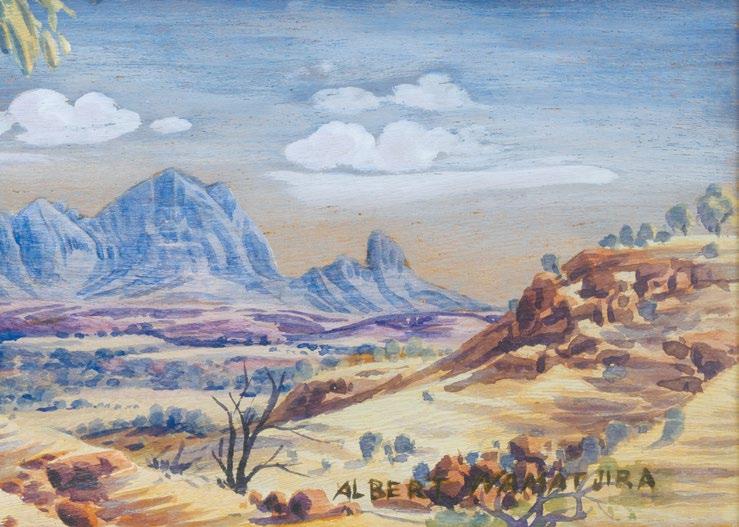
9
51 x 60.5 cm; 54.5 x 64.5 cm (framed) natural earth pigments on canvas
EST $10,000 - 15,000
Painted at the Warmun Pensioner Unit for Neil McLeod Fine Art, Vic Private Collection, Vic

Queenie McKenzie was born on Old Texas Station on the Ord River in the north west of Western Australia. As a young girl she began her life of cooking for the stockmen, tending and riding horses, and journeying as they drove cattle across the vast pastoral region of the north.
During the 1970s, Queenie, then in her 50s, played a leading role in community affairs and experimented with representational art as an educational tool in the local school. She taught Gija language and cultural traditions as part of the ‘two-way’ education given at the school. Besides helping to maintain ancient knowledge of sacred sites and the Dreaming mythology, it seamlessly paralleled bible stories and provided the youth with both a spiritual awareness and an involvement in community activities.
These are the hills of Old Texas Station. The hills are depicted in a variety of colours. The trees are the old ghost gums that grow here. Queenie remembered being tied to one when she was young after trying to run away from the Police. Horseshoe Creek is shown running between the hills. There was an anthill on the way to this place. It was small when Queenie was a little girl and it grew bigger and bigger as she progressed throughout her life.
Commissioned by Rodney Gooch for Utopia Art, NT, Cat No. 12-789 Utopia Art, NSW
Private Collection of Gerald and Mary Reid Brunstrom, St Louis, USA Private Collection of Gordon Anderson, NSW
Queensland Art Gallery, Alhalkere Paintings from Utopia, Qld, 1998, illustrated p.2
Austral Gallery, Art from Utopia, 1989, St Louis, USA
Queensland Art Gallery, Emily Kame Kngwarreye Retrospective, Alhalkere Paintings from Utopia, 1998, Brisbane, Qld
Australian Galleries, Cooee Art Gallery at Australian Galleries, 2016, Sydney, NSW
According to Aboriginal culture, the material and the spiritual are inseparable. This small work, with a very distinguished exhibition history, exemplifies this holistic view. It appears as if simply covered in all-over patterns of brown ochre spots on white, red and black dots. In the late 1980s, when this work was created, James Mollison, then Director of the National Gallery of Victoria, thought this to be simply figurative and depicting seeds when visiting the CAAMA shop in Alice Springs, a supposition that was supported when he found a drawer full of red and black seeds nearby. They became known thereafter as Emily’s ‘seed paintings’, though they are so much more than that. Emily was said to have cupped her hands together as if imitating the shape of Intekwe, the seed pod that holds the Kame seeds, and whispering ‘I am these seeds, these seeds are me’.
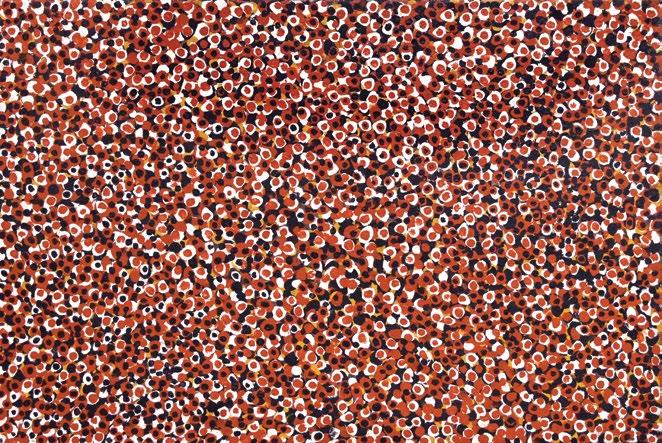
Collection,
Collection,
Centre,
Bill Whiskey did not begin painting on canvas until the last four years of his life at 84 years of age, by which time he was widely renowned as a powerful healer and keeper of sacred knowledge. His paintings, the first to depict the major Dreaming story and the creation of major sites throughout his country, are imbued with authority and steeped in traditional knowledge.
In this painting of rock holes and country near Kata Juta, water places such as Pirupa Akla are marked by a set of concentric circles. Their dazzling presence represents their powerful life-giving significance, rather than their actual size.The actions of the White Cockatoo and Crow ancestors are encrypted as dotted patches that reference topographic features associated with the Dreaming.

Aboriginal Fine Art, NT, Cat No. AA31/22507
Japingka Aboriginal Art, WA, Cat No. Jap 008453

Private Collection, Vic
Accompanied by a certificate of authenticity from Japingka Aboriginal Art
Mawurndjul painted collaboratively with his older brother, Jimmy Njiminjuma, until the late 1970s. At this early stage in his painting career, the primary subject matter for his work was the mythology of the surrounding environment at Memalingkan. Throughout the early to mid 1980s, Mawurndjul painted small barks of Ngalyod (the Rainbow Serpent), other spirit beings including Namarrkon (the Lightning Spirit), and various depictions of the local natural species, such as fish, bandicoots, and possum.
Mawurndjul was an heir to the long painting tradition of Kunwinjku artists, exemplified in barks by Yirawala, Peter Marralwanga, and Mick Kubarkku who incorporated rarrk designs into their art – though this ‘design element’ remained secondary to the figurative elements. By the mid 1990s, Mawurndjul had allowed the rarrk designs to dominate, filling both the interior and surrounding space of his figures. In time he abandoned figurative iconography all but completely. This work is a very rare exception on paper.
MOUNT NEWMAN, 1995 64 x 49 cm; 89 x 79 cm (framed) coloured etching and aquatint, ed.6/50

$4,000 - 6,000
Studio One Inc., ACT Private Collection, NSW
Rover Thomas was born in the Warburton Ranges south of the Great Sandy Desert in Western Australia. He spent most of his life in the Kimberley region where he worked as a stockman after being taken from Balgo Hills as a 12 year old child.
He moved to Turkey Creek in 1975 and shortly thereafter had a major revelation as the result of the accidental death of a female relative in the Darwin Cyclone.The visitation by the spirit of the dead woman transformed his life and the art of the region. He began exhibiting in 1987 and is represented in the collections of all major Australian galleries. His work has been shown in exhibitions throughout the world including the Venice Biennale.
This screen print was produced during a workshop that was organised by Adrian Newstead and Studio One and was conducted in the Warmun community at Turkey Creek from the 12th till the 26th of April in 1995.
FRONTIER LIGHTS, 2005 100 x 97 cm; 132 x 125 cm (framed) screenprint and collage on paper with graphite and diamond dust, ed.7/7

EST $6,000 - 8,000
PROVENANCE
Stills Gallery, NSW, Edition 7/7
Annette Larkin Fine Art, NSW
Private Collection, NSW
Signed below image
EXHIBITED
Stills Gallery, Brook Andrew: Hope & Peace, 2005, Sydney, NSW
Annette Larkin Fine Art, A Private Collection II, 2015, Sydney, NSW
Through his work, in a variety of areas, Brook Andrew is a fervent and forthright social commentator who explores the history of race relations in Australia, as well as colonialism, ethnography, cultural identity, gender politics, globalisation, and other themes. By employing powerful postmodern imagery, delivered with sociological savvy and slick visual appeal, his high impact, high-energy works are immediate, urgent, and can be at once both beautiful and humorous.They comment on, and elicit responses from, both Indigenous and non-indigenous viewers through a variety of computer-generated photo-media, including conventional screen print neon projected onto large-scale screens lit from behind, and printing on to Duraclear, a material conventionally used in advertising. Created on a large scale, and produced in a refined yet glossy pop style, his works are provocative, challenging, and visually dynamic.
15
DESTINY DEACON (1957 - )
BORDER PATROL, 2006 80 x 100 cm; 98 x 128 cm (framed) light jet print from scanned Polaroid original, ed.2/8
$8,000 - 10,000
Roslyn Oxley9 Gallery, NSW, Edition 2/8
Annette Larkin Fine Art, NSW Private Collection, NSW
Signed lower right
Roslyn Oxley9 Gallery, Destiny Deacon’s Totemistical, 2006, Sydney, NSW
Annette Larkin Fine Art, A Private Collection II, 2015, Sydney, NSW
Destiny Deacon is of KuKu (Cape York) and Erub/Mer (Torres Strait) heritage. Her photographs are often spontaneous and playful set-ups of visual puns and cheeky parodies.
The image, first taken using Polaroid film and later printed in enlarged form as a lightjet print, features a doll - a recurring character in her photographs. Deacon collects rescued objects from second-hand shops and ‘adopts’ them in order to build a collection of characters for the stories she tells. Deacon toys with the serious consequences of racism and the melancholy legacy of the families of the Stolen Generations.

LIN ONUS (1948 - 1996)
GUMBIRRI GARGINING, 1996 50 x 74.5 cm; 80.5 x 103.5 cm (framed) screenprint on paper, ed.29/85
EST $3,500 - 5,500
“As an indigenous person, Lin could not just paint any animal he wanted. After meeting and chatting with the owner of the rights to the turtle totem, Lin was granted permission and part of the exchange included two pairs of blue-jeans. When it came to printing the last colour, the blue wash, I was not entirely happy with the colour nor the transparency of the ink. I tried to reach Lin many times to check the tests but he was not available. In the end I had to print the whole edition in its current state. The next day Lin came to sign the edition and he preferred the colour in the experimental edition too. I took the two experiments as my Printers Proofs…Here is one from the limited edition.”
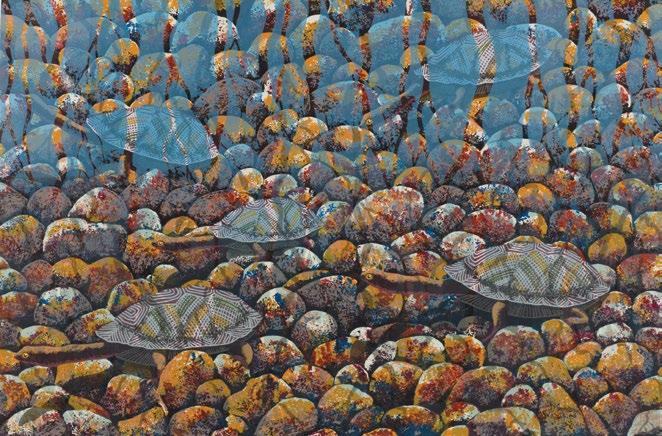 - Shaike Snir, Printer
- Shaike Snir, Printer
Aweyle
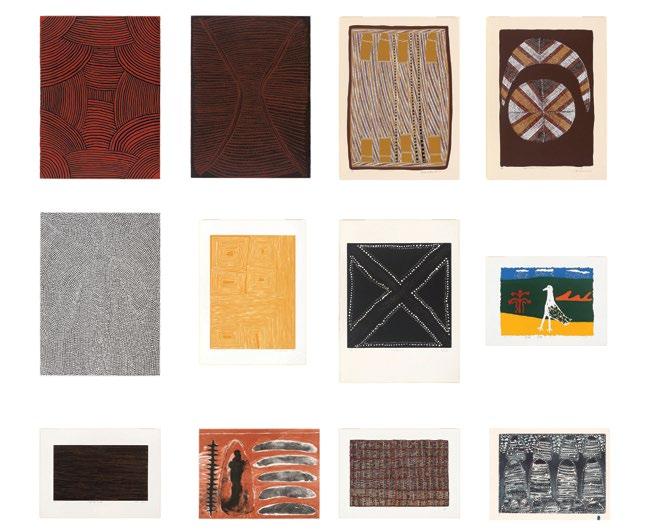

Johnny Mosquito was born in the Great Sandy Desert circa 1920, and walked into the old Balgo mission in his 20s. During his lifetime he became the most senior ‘rainmaker’ in the Balgo Hills community and was responsible for all of the Dreamings associated with rain including rainbows, thunder, clouds, and lightning.
In this arid landscape, there is a particular gravitas attached to stories concerning permanent water sources, referred to by the inhabitants with whispered reverence as ‘living water’. These precious watercourses, rockholes, and clay pans of Johnny Mosquito’s country were the dominant motifs in his art.
Often employing brilliant shades of blue to depict water, he also used red and occasionally yellow, separated solely by minimal white linear dots to delineate blocks of flat colour in emphasising the most important features. This contrast between his use of flat colour and vibratory dots is superb, and reaches its zenith in Johnny Mosquito’s 1993-1996 paintings.
Johnny Mosquito is revered as having been one of the first generation of Balgo painters. Every canvas he created, even those painted at the very end of his life, reveals an interior landscape redolent with meaning and charged with energy. His longing for the distant sites visited by the great creation ancestors and sung throughout the millennia found its ultimate expression in his art.
PROVENANCE Neil McCleod Fine Arts, Vic, Cat No. NM4802 Private Collection, Vic
Accompanied by a certificate of authenticity from Neil McCleod Fine Art and an image of the artist with the completed work
During the last decade of her life, Patsy Lulpunda lived on the Price Regent River near Mowanjum and created hair belts, stone axes, and other items of material culture. Her first paintings were created at the age of 100, whilst visiting the great Kimberley custodian and storyteller Jack Dale during a workshop organised in 1998. She participated in several painting workshops at his home before her death at 102 at the start of the millennium.
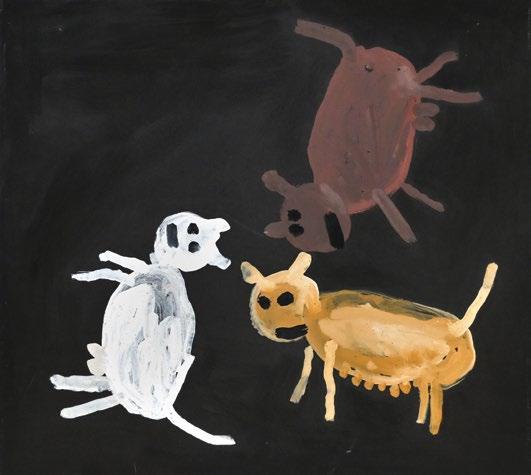
Lulpunda’s Wororra name ‘Anguburra’ refers to the native honey bee that produces the most exquisitely tasting honey. It was a delightful and most fitting name for a woman whose sprightly and spirited engagement with life extended her autumn years beyond all expectation.
Anguburra witnessed and experienced great cultural transformations during her long life, given her presence when Wororra culture was yet to experience the influence and impact of European culture.
Aboriginal Gallery of Dreamings, Vic, Cat No. 12742 Private Collection, Vic
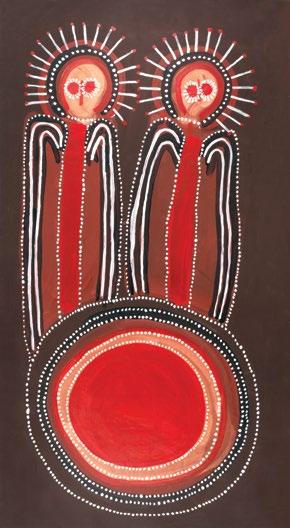
Accompanied by a booklet of authenticity from Aboriginal Gallery of Dreamings
As one of the last of the dwindling generation of old men who possessed complete knowledge of the rituals, law, and culture of his people, Jack Dale was a vital link to the past. His most compelling and mysterious works focus on the Wandjina and other important spirit beings that created the land and instituted the laws that govern human behaviour. Wandjinas are powerful fertility spirits, responsible for the life-giving monsoon rains. Dale depicted these spirits in a distinctive style: ghost-like, with halos, and large, dark, poollike eyes, without mouths, as he believed that giving them a mouth would mean the heavens would open and the rain would never cease.
These Wandjina sites, located throughout the Kimberley, are over 60,000 years old and are painted on rock overhangs, often marked by striking geological features like the Djalala or ‘marking stones’ that indicate their presence. “Whites have the bible. We have our Wandjinas. We have to go to these places else we are empty,” said Dale.
Sometimes referred to as the ‘Grand Old Man of the Kimberley’, he came to painting late in life, after many hard-working years as a stockman. Even then, he was revered for his extensive knowledge and admired for his physical strength and determined attitude.
FREDDIE TIMMS (1946 - 2017)
BOW JUNCTION, 2011
102 x 102 cm
natural earth pigments on canvas
EST $6,000 - 8,000
Artlandish, WA, Cat No. FT459
Private Collection, NSW
Accompanied by a certificate of authenticity from Artlandish and an image of the artist holding the work
Signed verso
100 x 100 cm
natural earth pigments on Belgian linen
EST $8,000 - 10,000
Narangunny Traders, WA, Cat No. JB0087
Lawson~Menzies, Aboriginal Art Auction, Lot 8, Sydney, November 2004 Private Collection, NSW
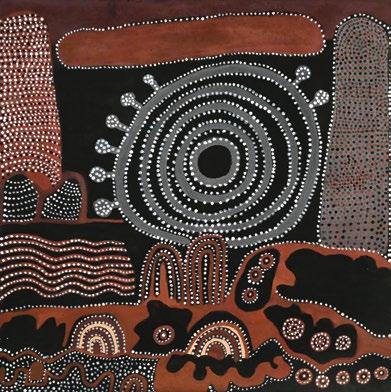

c.1970
x 20 cm (irregular)
earth pigments
$25,000 - 30,000
Created at Gibb River Station, WA Sotheby’s, Aboriginal Art, Lot 76, Sydney, July 2003 Private Collection, NSW
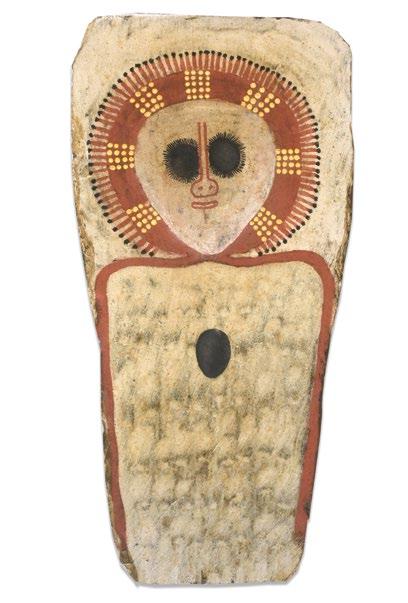
Inscribed verso ‘Gibb River, Kimberley, W. Australia, NR-4793-5’
Charlie Numbulmoore lived for many years on Gibb River Station in the Central Kimberley where anthropologist Ian Crawford first recorded him repainting Wandjina figures in a Mamadai cave during the 1960s. The few biographical details of Numbulmoore’s life that exist are traced solely through his encounters with those anthropologists who collected his work. Following Crawford’s initial encounter, Helen Groger-Wurm collected the artist’s work on behalf of the Australian Institute of Aboriginal Studies in 1970, the same year that collector and grazier Tom McCourt purchased a number of paintings on bark, plywood, and cardboard. In his journal, McCourt recalled Numbulmoore as ‘the last of the old people here… who has that certain something that impresses you… when I was in Charlie’s camp, I bought several paintings he had in his hut from him… although his work is childlike, it has the primitive look of paintings seen under the rock hangings out in the bush’ (cited in Sotheby’s 2003: 10).
DREAMING PLACE, 1982 213.5 x 91 cm; 217.5 x 95 cm (framed) natural earth pigments on board
EST $50,000 - 70,000
Neil McLeod Fine Art, Vic Private Collection, Vic
Accompanied by a certificate of authenticity from Neil McLeod Fine Art
Paddy Jaminji was born on Bedford Downs Station in the North East Kimberley and spent most of his life working as a stockman on both Bedforn Downs and Old Lissadell Stations. He was the first painter in Turkey Creek after a strike by Kimberley Station workers in the mid 1970’s signalled a mass Aboriginal exodus from cattle properties. Uncle to Rover Thomas, he was the inspiration behind Rover’s decision to paint and went on to inspire many others including Lena Nyadbi. Painted at Bedford Station.
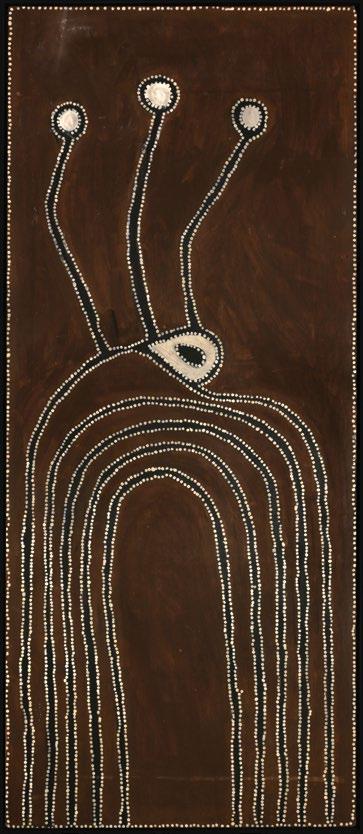
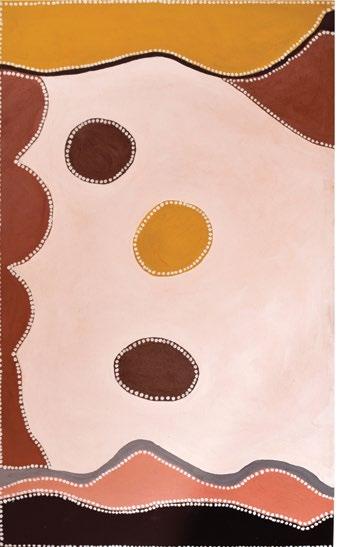
Freddie Timms began painting in 1986, inspired by the elder artists already painting at Frog Hollow, a small outstation attached to the community at Warmun, Turkey Creek. Born at Police Hole c.1946, he followed in his father’s footsteps, following the stockman’s life at Lissadell Station. At the age of 20, he set out to explore and work on other stations. It was during this time that he met and worked alongside Rover Thomas who was to have a lasting influence on him. In 1985, he left Lissadell once more to settle at the new community established at Warmun where he worked as a gardener at the Argyle Mine.
In a career that spanned more than 20 years, Freddie Timms became known for aerial map-like visions of country that were less concerned with ancestral associations than with tracing the responses and refuges of the Gija people as they encountered the ruthlessness and brutality of colonisation. However, his political nature was characterised by more intimate interpretations of the experience rather than overtly political statements. Freddie Timms was foremost amongst those Gija artists of the second generation. His was a unique Gija perspective on the history of white interaction with his people. It is hard to think of another who expressed more poignantly through their art the sense of longing and the abiding loss that comes from the separation from land that embodies one’s spiritual home.
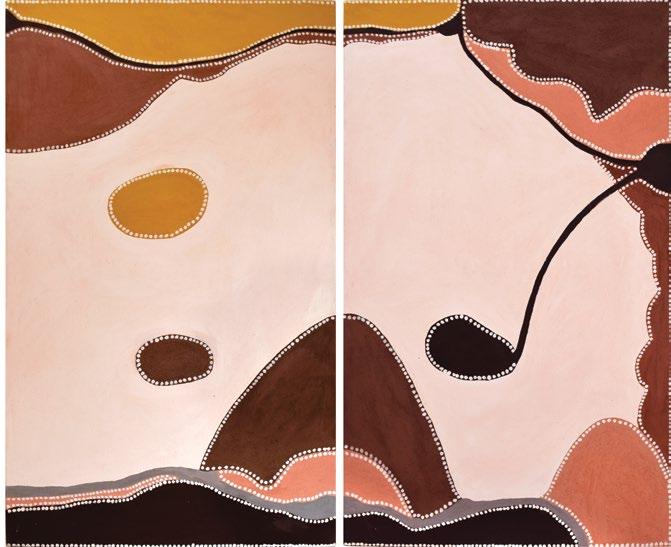
26 MICK NAMARARI TJAPALTJARRI (1926 - 1998)
DINGO CEREMONY, 1972 50.5 x 50.5; 52.5 x 52.5 cm (framed) synthetic polymer powder paint on composition board EST $80,000 - 100,000
Painted at Papunya, 1971-72, NT Stuart Art Centre, NT Private Collection, SA Sotheby’s, Aboriginal Art, Lot 133, Melbourne, July 2001 Sotheby’s, Aboriginal Art, Lot 231, Sydney, July 2003 Private Collection, Vic Accompanied by a copy of the book Papunya A Place Made After the Story by Geoffrey Bardon and James Bardon
Bardon, G and Bardon, J., Papunya, A Place Made After The Story, The Beginnings of the Western Desert Painting Movement, The Miegunyah Press, Melbourne University Publishing, 2004, illustrated with copy of Bardon’s original field note p. 256
Mick Namarari travelled to many of the key sites through Pintupi country during his childhood, and following his initiation into manhood, was responsible for maintaining the knowledge and ceremony of its many ancestral sites.
During a career that spanned almost three decades, Mick Namarari’s variety of subjects and diversity of stylistic approaches kept him at the forefront of Western Desert painting for almost three decades. Geoff Bardon noted his ability as a painter from the earliest days of the movement when he ‘could often unexpectedly be found late at night working away at his meticulous and marvellous paintings’ (Johnson 2000: 191).
Symbolic designs such as those seen in this painting, were often depicted on a black or rich, earthy background, with a sharpness of line that imbued them with a remarkable clarity. The key formal elements provided the basis for Namarari’s later works as he constantly explored and expanded upon their aesthetic potential. He would unravel endless variations on one Dreaming story by focusing on different aspects of its telling. His inventive array of techniques demonstrated a singular and personally felt perspective that always managed to take his audience by surprise.
In this very early example, Namarari depicted a ceremonial hair piece on the left alongside two ceremonial objects. The central motif is a dance board inscribed with markings related to the travels of the ancestral dingo. The top section of the right-hand board is decorated with body paint pattern while the bottom section is a disguised ceremonial hat, comparable to imagery adopted by his contemporary Tim Payungka during the same period ( Bardon and Bardon 2004: 256).
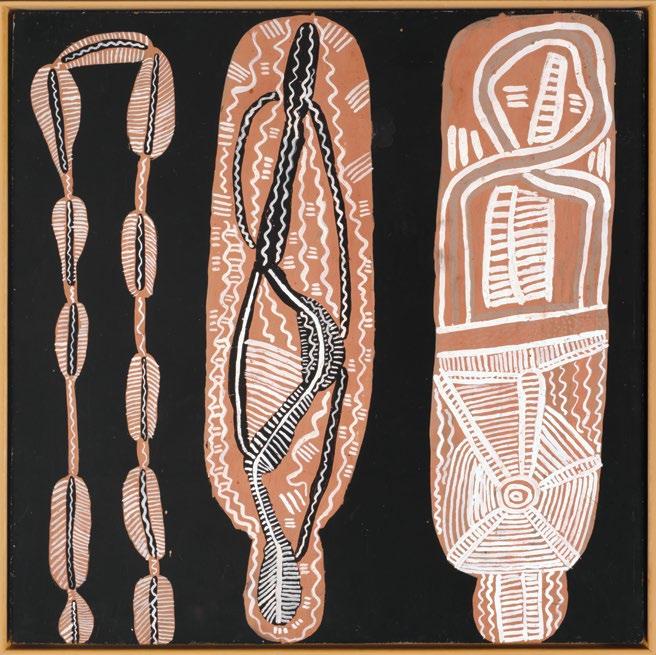
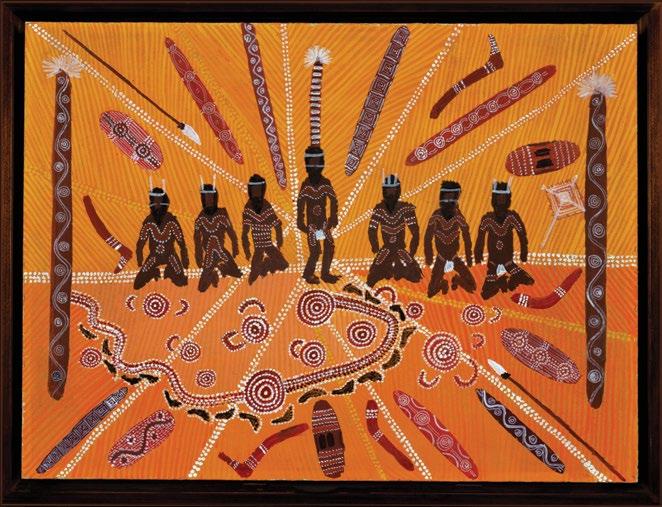

Image of Clifford Possum as a young man taken in 1977 by Jon Falkenmire

Clifford Possum Tjapaltjarri is widely renowned as one of the the greatest innovators in the annals of Western Desert Art, and of the entire Aboriginal art movement. He was the first recognised star of Western Desert art and one of Australia’s most distinguished painters of the late twentieth century.
Tjapaltjarri and his ‘brother’ Tim Leura worked on the construction of the Papunya settlement during the early 1950s joining their cousin Kaapa Tjampitjinpa whose first paintings were created in a similar figurative style.
He began his artistic career at Glen Helen producing carvings for the developing tourist market that were renowned in Central Australia for their brilliant craftsmanship.
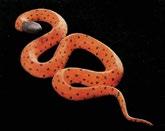
In the early years of the Papunya acrylic painting movement, it was not uncommon for artists to depict ceremonies and ritual objects in a naturalistic, figurative fashion, though the stories that accompanied them were scarce and perfunctory. As soon as they began to be sold outside of Papunya however, their public display became a focus of disquiet, and the artists knew they would have to tone down the content radically. Nevertheless, in spite of Bardon’s objections,Tjapaltjarri, unlike most of his contemporaries, continued to embrace unusual design elements, and forms of figuration, in his work.
This particular painting features figurative renderings of men undertaking ceremony surrounded by ceremonial objects and paraphernalia which include restricted information, that could not be revealed to women, uninitiated men and outsiders. He said of it at the time:
’I cannot tell you the whole story or you and I would die’.
The painting has a proto-symmetrical composition and a chromatic range that features yellow and orange, and sections of parallel lines that form the ground of the painting. It is very finely crafted with detailed renderings of the ceremonial objects and body designs.
According to Wally Caruana, the former curator of Aboriginal art at the National Gallery of Australia, this painting is: ‘a significant and unusual work in the artist’s oeuvre. It is a small yet luminous work that emanates a numinous quality.’
Anthropologist John Kean has commented that this painting is: ‘an encyclopaedic representation of the objects associated with a particular ceremony, and that some of the objects certainly refer to the restricted ceremonial context’
The details of the figures, the footprints and hatching, and the overall brushwork is notable for having been created by an artist already well grounded in figurative representation yet committed from the outset of his career to experimentation.
While Tim Leura became a founding member of Papunya Tula Artists when it formed in 1971, Clifford Possum Tjapaltjarri did not join the growing band of active painters working with art teacher Geoffrey Bardon until February 1972. This painting was amongst a handful created prior to his joining the collective. He was painting primarily for himself, without any thought of an audience other than his countrymen and those, like Bardon, who they trusted. Though he knew that revealing its full content could risk retribution and rebuke, he explained at the time in The Centralian Advocate that:
‘This story is part of my religion, but not the whole story which is out there (in the bush) and in my mind’
This is believed to have been Clifford Possum Tjapaltjarri’s very first painting. His use of spatial configuration beyond the more conventional Papunya idiom of dots, circles and lines is in evidence. Human figures are seen kneeling down, ritual poles stand up, a ground painting appears at an odd angle creating a three-dimensional sense. Radiating lines of parallel dotting emanate from the dance ground creating a radiant numinous atmosphere, and focus the eye on the central horizon. The sacred objects including churingas, boomerangs, spears, dance wands and shields surround the ceremonial participants and appear as if flying off like sparkles from a roman candle. On either side, two massive churingas hold the image tightly in the manner of Albert Namatjira’s gum trees, adding weight to the
edges of the painting, thereby drawing the viewers eye into the painting’s centre. This inventiveness set Tjapaltjarri on a creative path that stands apart from those of other Western and Central Desert artists who were less preoccupied than he with evoking a psychological mood in their art. In another first, he incorporated the fine parallel venation as seen in the striated fluting on sacred and ceremonial objects into the background’s decorative infill in such a way as to create an emanating force field around the participants.
The companion piece to this work, created almost simultaneously, was offered for sale at Sotheby’s in July 2004 (Lot 97). It is divided into two parts: in the upper section, the subjects are depicted naturalistically in profile view while in the two lower sections the artist has adopted a planar view including roundels surrounded by U shapes indicating people, and the lines or tracks joining the three sites.
Both paintings depict a ritual in progress. Decorated figures wearing headdresses are seen dancing. Sites are joined by a travelling line and included are dance boards, ceremonial shields, boomerangs, spears and sacred churingas.
Two other paintings created shortly thereafter are worth mentioning in this context:
Emu Corroboree Man of 1972 was painted about 6 months later and was the first painting created by Clifford Possum Tjapaltjarri for the Papunya Tula Artists cooperative. He painted the main figure and all the major elements, including the heraldic emus, prior to adding the lines of hatching and the fields of dots. The painting depicts the Emu Man (presumably the artist’s cousin, Kaapa Tjampijtinpa who was a leader of Emu Ceremonies [Johnson 2003: 64] in full regalia holding a shield bearing Emu designs and two large boards behind his back and surrounded by ritual objects.The ancestral Emu is represented naturalistically and by its tracks, while the waterholes appear as white roundels, surrounded by emu tracks.
While these small early career works were a mere foretaste of the grandeur of the paintings Tjapaltjarri was to create on an unprecedentedly massive scale in the late 1970s , they are amongst the ‘crown jewels’ of the entire Aboriginal art endeavour. Tjapaltjarri went on to create magnificent paintings that have been described as ‘beautiful palimpsests’ of his extensive multiple Dreaming sites, seen from shifting viewpoints in space. Yet he continued, throughout his career, to include Western iconography and figurative imagery in his art to convey certain elements in his narratives. This played a dual role in both making them more intelligible to Western audiences, and allowing him to create imaginative compositions within the parameters of the ‘law’.
No life was written larger across the page of the Aboriginal Art Movement than that of Clifford Possum Tjapaltjarri. During a career, which lasted more than 30 years, he produced a number of masterpieces that are amongst the most important works created in this country’s artistic history. He received an Order of Australia for his contribution to the Western Desert art movement, was Chairman of Papunya Tula in the late 1970s and early 1980s, had a private audience with Queen Elizabeth II in 1990, and was the first real Ambassador for Aboriginal
art around the world. He also has the distinction of having painted the most expensive Aboriginal art work ever sold publically: the monumental 1977 masterpiece Warlugolong was purchased by the National Gallery of Australia for $2,400,000, a record for an Australian Aboriginal artwork that has never been beaten.
Untitled - Possum Dreaming, is a small work but a highly significant one. It is one of only four works by the artist in the ‘School of Kaapa’ style. Critically, none of these works are in public collections in Australia.
Its subject is of particular significance. The painting is believed to be the only early Western Desert work in which a ceremony is painted in such great detail. Given these facts, the artist’s biographer and close friend Dr. Vivien Johnson has argued that it is:
‘vital for the early history of Papunya painting, arguably Australia’s most significant art movement, that this work be retained here in Australia, if possible in a public collection.’
1. Carved and Painted Snake, c.1977 synthetic polymer paint on carved softwood 25 x 10 x 1.5 cm
2. Snake Carving, c.1975 carved beanwood and watercolour 68.5 x 40 cm
3. Untitled (Emu Corroboree), 1972 synthetic polymer paint on composition board 51 x 35 cm
4. Emu Corroboree Man, 1972 synthetic polymer paint on composition board 46 x 61.5 cm

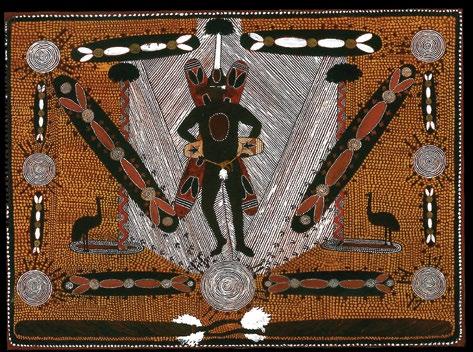
28
RONNIE TJAMPITJINPA (c.1943 - )
TINGARI CYCLE, 1998
152.5 x 183 cm; 153.5 x 184 cm (framed) synthetic polymer paint on Belgian linen
EST $30,000 - 40,000
Papunya Tula Artists, NT, Cat No. RT960446 Aboriginal Gallery of Dreamings, Vic, Cat No.7264 Private Collection, Vic
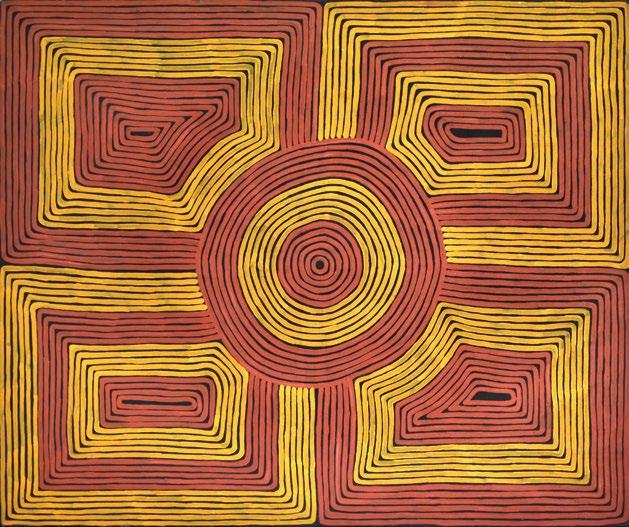
Accompanied by a certificate of authenticity from Papunya Tula Artists, and a booklet of authenticity from Aboriginal Gallery of Dreamings
Ronnie Tjampitjinpa walked with his family out of the West Australian desert and settled into life at the tumultuous and crowded settlement of Papunya at 13 years of age. He was in his late 20s at the dawn of the Desert painting movement. He became one of the youngest painters for Papunya Tula and, during the early years, was tutored by Old Mick Tjakamarra.
Ronnie was foremost amongst those who transformed Pintupi men’s painting style during the early to mid 1990s. His work was subsequently included in a number of major survey exhibitions in Australia and overseas, culminating in a solo retrospective in 2015 at the Art Gallery of NSW.
The Tingari song and dance cycles are the most secret and sacred of the deeply religious rituals of the Western Desert Tribes of Central Australia. The rituals associated with them consist of hundreds of song and dance cycles telling of the travels and adventures of the Tingari and their creation of sacred sites and fertility rites.
Papunya Tula Artists, NT, Cat No. WT20000175 Private Collection, WA
Accompanied by a certificate of authenticity from Papunya Tula Artists
Warlimpirrnga had been living west of Lake Mackay before his small family group walked into the Pintupi community of Kiwirrkurra, where their relatives lived, in 1984. Prior to that, he’d had no contact with European Australians, though he was aware of their presence. His Pintupi relatives had almost all been brought out of the Gibson Desert decades earlier by the infamous ‘Pintupi Patrols’, forcing them to settle in Haasts and Papunya. He commenced painting for Papunya Tula Artists in 1987. The following year, he had his first solo exhibition at Gallery Gabrielle Pizzi in Melbourne. In 2016, his works featured in a solo exhibition at the renowned Studio 94 Gallery in New York.
Like many other Western Desert paintings, the work is a topographical aerial view of ancestral lands. The Tingari beings arrived at this site west of Wilkinkarra (Lake Mackay) from the west, travelling beneath the earth’s surface to create the ridges and windswept sandhills that unfold, pulsating and radiating across the canvas. Waves of sand ridges and dunes are depicted by constructing a matrix of parallel meandering and zigzagging lines. These are the same as those incised into traditional ceremonial objects, including hair pins, boomerangs, and shields made by senior artisans amongst desert peoples.
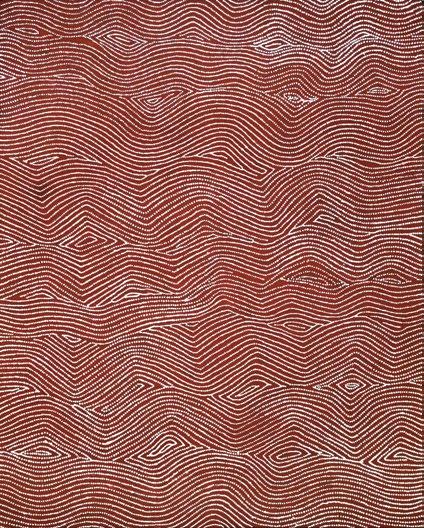
- )
WATER DREAMING, 2008
x 91 cm
polymer paint on Belgian linen
- 18,000
Papunya Tula Artists, NT, Cat No. RT0805034 Private Collection, SA
Accompanied by a certificate of authenticity from Papunya Tula Artists
Ronnie Tjampitjinpa’s works first appeared in Papunya Tula exhibitions during the 1970s, and later in commercial art galleries in Sydney and Melbourne throughout the 1980s. He won the Alice Springs Art Prize in 1988, followed by successive solo exhibitions at Gallery Gabrielle Pizzi in 1989 and 1990.
More than any other Western Desert artist, Ronnie Tjampitjinpa can be credited with having forged a new artistic direction in embracing aesthetic minimalism during the 1990s. His hypnotic designs explore interacting geometric shapes which evoke an eye-catching, pulsating illusion. Still infused with the Dreamings of his mythical Tingari ancestors, Tjampitjinpa refined the characteristic Pintupi simplicity of design, boldly scaling up fundamental pictorial elements, freeing them from their iconographic reference points and strongly emphasising the distinctive repetition of line and form that has always infused Pintupi art with the spirit of their vast and ancient lands.

2004
x 136.5 cm; 124 x 139 cm (framed)
polymer paint on Belgian linen
Papunya Tula Artists, NT, Cat No. GW0408202 John Gordon Gallery, Steve Bush Collection, NSW Private Collection, NSW

Accompanied by a certificate of authenticity from Papunya Tula Artists
George Ward arrived in Papunya in the early 1960s while still in his teenage years and worked as a fencer and butcher in the community kitchen. Although born to different mothers, he shared the same father with Yala Yala Gibbs and Willy Tjunurrayai, and when he began to paint in 1976, he assisted these senior artists who worked within the tightly knit group of established Pintupi painters.
Though he was reputed to have completed several canvases during the early 1980s, George Ward did not begin painting in earnest until after the death of his brother Yala Yala Gibbs in 1998. Thereafter, he rapidly developed his own style based on the men’s key designs used to incise ceremonial artefacts, including dance regalia, with their mesmeric interlocking geometric and parallel linear patterning.
This painting depicts designs associated with the site of Kaakuratintja (Lake McDonald). In mythological times, a Tingari man visited this site before travelling west to Patantja. As he travelled, he carried two Kuniya (pythons) with him. One large venomous snake also travelled west from Lake McDonald. According to Pintupi mythology, the Tingari travelled over vast stretches of the country, performing rituals and creating and shaping particular sites during the Dreamtime.
ARAFURA SWAMP SCENE, 1993
x 62 cm (irregular) natural earth pigments on bark
- 6,000
Bula’bula Arts, Ramingining, NT, Cat No. BP1390 Private Collection, NSW
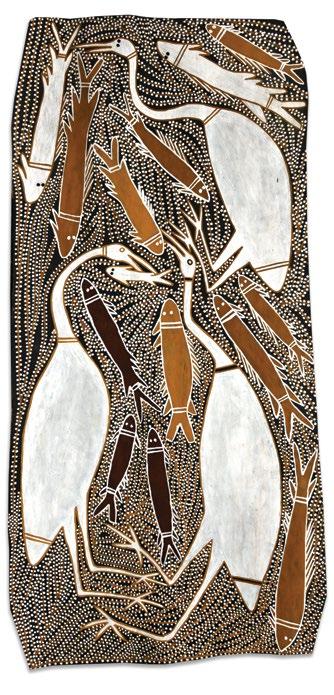
George Milpurrurru was raised in his father’s country, Ngalyindi, the Ganalbingu outstation, which straddles a ridge to the east side of the Arafura swamp in Central Arnhem Land.The swamp, in the middle section of the Glyde River, is home to flocks of water birds, freshwater plants, snakes, and a rich array of other flora and fauna. This Eden became the wellspring from which Milpurrurru drew his artistic inspiration. He began to paint under the guidance of his father, Nhulmarmar and, as Judith Ryan observed, ‘Nhulmarmar’s art prefigures that of his son, Milpurrurru, in its capricious reversals of tone and patterning and its graphic power’.
Indeed, Milpurrurru’s mastery over the play between foreground and background characterises his paintings in which blocks of flat colour and intricate rarrk cross-hatching create a strong graphic effect. His style traversed stylistic conventions across Arnhem Land and synthesised these into highly designed compositions. In doing so he drew on the aesthetic traditions of Western Arnhem Land artists who applied cross-hatching solely within the figurative or schematic motifs of the work, while at the same time borrowing on the Eastern Arnhem Land convention of leaving figures unadorned. Yet even in this variation, Milpurrurru stood outside Eastern Arnhem Land conventions in preferring to create complex arrangements of intersecting patterns.
BARNUMBIRR PAINTING, 1990
112 x 53.5 cm; 132.5 x 73 cm (framed) natural earth pigments on bark
Maningrida Arts & Crafts, NT, Cat No. WUN42 Garry Anderson Gallery, NSW Private Collection, NSW
Accompanied by a certificate of authenticity from Maningrida Arts & Crafts and an image of the artist’s children with the completed work
Jack Wunuwun was a senior custodian of the elaborate Barnumbirr or Morning Star ceremony. This continues to be performed in order to establish and reinforce trade and friendly relations between peoples from distant places across Arnhem Land. The spirits of the land keep the Morning Star in a dilly bag during the day. Barnumbirr is attached to a string and, as dawn approaches, it is released into the sky. When dawn breaks, the string is pulled to return Barnumbirr to its dilly bag. The religious stories and ceremonies associated with Barnumbirr are symbolic of life, death, and regeneration. The painting depicts Barrdje, yam leaves, and Bunpa, butterflies associated with Barnumbirr, the Morning Star ritual. The jungle site shown here is known as Mewimbi which is the artist’s country. The work was painted at Gamerdi outstation where the artist lived with Johnny Bulun Bulun. It was here that they adopted the artist Lin Onus into their clan and gave him the right to paint their own rarrk designs and the butterfly story that adorns this particular bark painting.
The painting demonstrates seasonal change at the end of the wet season, when fruit and yams ripen, flowers bloom, and insects flourish (it was here that he was filmed for Curtis Levy’s 1980 documentary Morning Star painter, narrated by the actor David Gulpilil).
Wunuwun’s use of perspective and three-dimensionality was incredibly innovative. Wunuwun viewed art as a means to achieve reconciliation between Indigenous and non-Indigenous Australians, and this philosophy is inherently reflected in his art.

Painted at Garthalala, NT
Buku-Larrnggay Mulka Arts, NT
Private Collection, NSW
Joel Fine Art, Aboriginal Art, Lot 88, Melbourne, June 2008 Private Collection, NSW

This painting, the second Datjirri produced in 1997, was painted at his new wife’s country at Garrthalala. In his new role as a husband along with recently bestowed clan based responsibilities of Yolŋu Rom (law) to uphold, he painted the country he had not lived in for some time.
His father’s homeland is Gurrumuru, belonging to the Ṉarrkala group. This painting is of other Dhalwaŋu land at Gaṉgaṉ, the source of Yirritja lore.
At Gaŋgaṉ, Barama the Creator Being for the Yirritja arrived. He came from a river system that empties into the northern Blue Mud Bay area. With him he carried digging staffs that are symbolic today of deep-seated knowledge and are of a restricted nature. Datjirri celebrated his elevation in rank by painting the icons in the top panel of this work. He also painted the totems relevant to the activities that took place in these waters at Gaṉgaṉ. Minhala, the long neck turtle, as with Baypiṉŋa the saratoga fish, followed the directions of Barama up-stream from the sacred water hole from where he emerged. Garkman the frog was a witness, and in this painting is surrounded by the lifeforce within. As Barama emerged, the water streamed from his body. The diamond pattern the water made on his body became the template for the sacred Dhaḻwaŋu clan design for this freshwater site. Weed hung from his elbows - the zig-zag wake of Minhala - a manifestation of this is represented by the sacred feathered strings attached to the upper arm that are used today by appropriate participants in ceremony. Below this area, down-stream, is a natural barrage - remnants (or a manifestation) of an object carried by an Ancestor.
Below this point on the painting, the sacred designs, again for water or the differing state of it, changes. The country depicted here is known as Burraltja. It is plains country, behind the northern beaches of Blue Mud Bay. It is country shared by another clan in a ceremonial sense rather than ownership. The other clans, the Maḏarrpa and the Dhaḻwaŋu, reciprocate with the relationship of kin - Mari / Gutharra, that of one with your mother’s mother. Here at Burraltja serpents, known as Lightning Snakes, reside. With the onset of the wet season, when freshwater flows from Gaṉgaṉ onto the plain, and the serpents taste the freshwater. This excites the serpents to stand on their tails and to spit lightning into the sky.
The sacred clan designs that fill the bottom half of this painting are of salt or ‘contaminated’ water. The elliptical shapes that are top-most in this section is a design belonging to the Dhaḻwaŋu clan - saltwater. The other ‘pinched’ design is of the same water (with mangrove leaves floating on top) belonging to the artists Mari clan. This important kinship relationship Datjirri enjoys with the Maḏarrpa gives the artist the right to paint another clan’s design although Yolŋu etiquette requires formal permission to do so.
GUNYBI GANAMBARR (1973 - )
2009

14
Buku-Larrnggay Mulka Arts, NT Annandale Galleries, NSW Private Collection, NSW
Gunybi Ganambarr, From my Mind, Annandale Galleries, NSW, 2012, illustrated p.48
Annandale Galleries, Gunybi Ganambarr; From my Mind, 2012, Sydney, NSW
Gunybi Ganambarr is a Yolngu artist who lives and works at Gängän, near Yirrkala in north-east Arnhem Land in the Northern Territory. He began his artistic career painting on bark and larrakitj, but has since extended his practice with an experimental and innovative use of reclaimed materials, which include wood, rubber, glass, steel, galvanised iron and aluminium. Under the tutelage of artists such as Gawirrin Gumana, and Yumutjin Wunungmurra from his mother’s Dhaḻwaŋu clan, Ganambarr has been able to assume ceremonial authority, and this has shaped the content he is able to depict in his work. (Museum of Contemporary Art, Sydney)
His first works of art were carved and painted Ironwood sculptures such as this innovative Wurran or cormorant (a totemic species of his mother clan). His work gained renown when he participated in the National Sculpture Prize at the NGA in 2005. He later won the Xstrata Coal Emerging Indigenous Artist Award at the Gallery of Modern Art at Queensland Art Gallery.

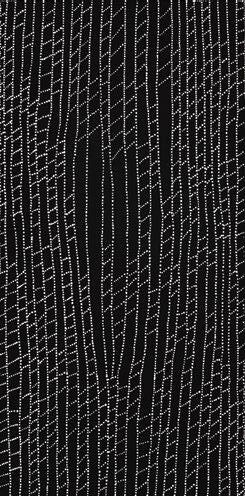
GLORIA PETYARRE
38
-
BUSH MEDICINE, 2002
polymer paint
Belgian
Tingari Arts, NSW, Cat No. KGP 02012 Private Collection, NSW
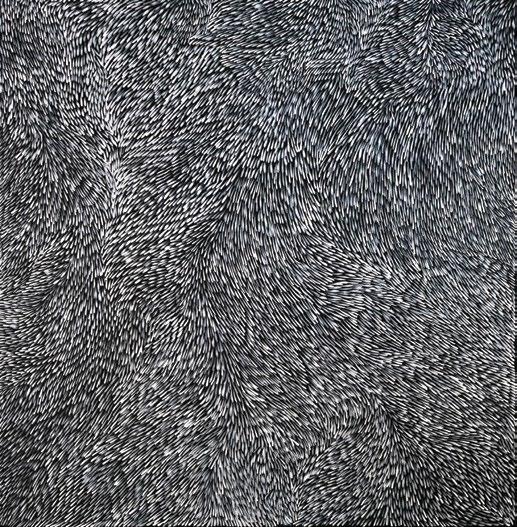
Accompanied by a certificate of authenticity from Tingari Arts and images of the artist working
Raised in a remote part of the Eastern Desert and initiated into Anmatyerre law and traditions, Gloria Petyarre participated in the first art programs organised at Utopia in 1977 when she was 35 years of age. These early batik-making workshops marked the emergence of Aboriginal women artists as a force in the desert painting movement.
This highly accomplished work represents the leaves of the Kurrajong tree, used in the Utopia region to treat a variety of ailments. The women collect the leaves, then dry and mix them with Kangaroo fat in order to extract the plant’s medicinal qualities.The significance of the Kurrajong tree and the part it plays in healing is celebrated in the women’s Awelye ceremonies.
In painting the Bush Medicine Leaf story, Gloria pays homage to the spirit of the medicinal plant. By re-creating its image, she encourages its regeneration, so that her people can continue to benefit from its healing powers.
Delmore Gallery, NT, Cat No. 95I009 Barry Stern Galleries Paddington, NSW Private Collection, NSW
The subject of this work is Arlatyeye, the Pencil Yam or Bush Potato. This is a valuable food source and the subject of important songs, dances and ceremonies amongst Eastern Anmatjerre people. It was the subject of a great number of Emily Kngwarreye’s paintings, which were created, most familiarly, in a vast array of vibrant colours. In this painting however, Emily has characterised the roots of the yam in the plant’s full period of maturity. As the foliage dies off, cracks appear in the ground, which trace the root system, and indicate that the engorged tubers are ready to be dug up and eaten.
Solid lines, stark and unadorned, trace the meandering paths of the pencil yam roots as they forge their way through the desert sands. Images such as this are always linked to Awelye - ceremonies that release spiritual power to maintain natures’ fertility and hardiness. Body painting lines are fundamental to the participatory role of women in these ceremonies.
This practice is symbolically linked to this work and helps evoke an atmosphere of ceremony. The belief that good seasons always return, that yam ‘always comes back’, is fundamental to understanding the desert environment and therefore survival. A parallel layer of expression runs with the fundamental understanding of Awelye , that being of basic human nature, understanding it, and abiding by the rules set down by society in order that it too, will survive.
Emily Kame Kngwarreye was born at Anilitye (Boundary Bore) and began creating paintings on canvas, when in her late 70s. She was awarded the Australian Creative Fellowship in 1992 and continued painting prolifically until her death in 1996.
Cf. For stylistically similar works see: ‘Wild Yam I, 1995’ in Janet Holt (et. al. ), ‘Emily Kngwarreye Paintings, Craftsman House, 1998, plate 70 illus. pp 166167 and various other works pp 168-180. See also the cover image of the Retrospective catalogue ‘Emily Kngwarreye, Alhalkere Paintings from Utopia, Margo Neale (ed), Queensland Art Gallery, 1998

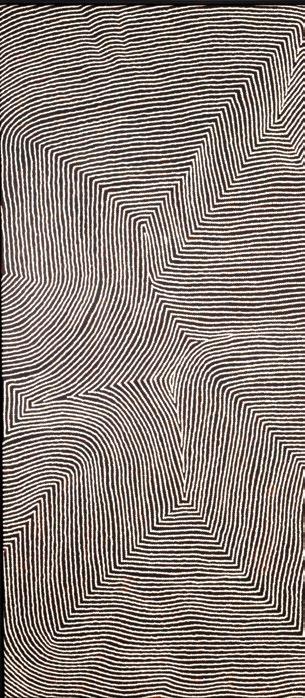
Warlimpirrnga had been living west of Lake Mackay before his small family group walked into the Pintupi community of Kiwirrkurra, where their relatives lived, in 1984. Prior to that, he’d had no contact with European Australians, though he was aware of their presence. His Pintupi relatives had almost all been brought out of the Gibson Desert decades earlier by the infamous ‘Pintupi Patrols’, forcing them to settle in Haasts Bluff and Papunya. He commenced painting for Papunya Tula Artists in 1987. The following year, he had his first solo exhibition at Gallery Gabrielle Pizzi in Melbourne. In 2016, his works featured in a solo exhibition at the renowned Studio 94 Gallery in New York.
Like many other Western Desert paintings, this work is a topographical aerial view of ancestral lands. The Tingari beings arrived at this site west of Wilkinkarra (Lake Mackay) from the west, travelling beneath the earth’s surface to create the ridges and windswept sandhills that unfold, pulsating and radiating across the canvas. Waves of sand ridges and dunes are depicted by constructing a matrix of parallel meandering and zigzagging lines. These are the same as those incised into traditional ceremonial objects, including hair pins, boomerangs, and shields made by senior artisans amongst desert peoples.
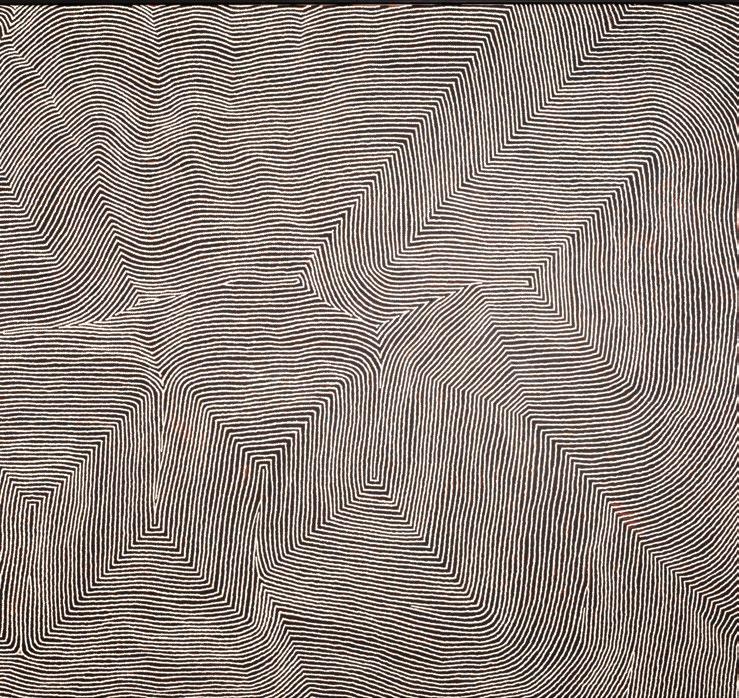
x 182 cm
polymer paint on Belgian linen
Papunya Tula Artists, NT, Cat No. TT990801 Private Collection, Vic
Accompanied by a certificate of authenticity from Papunya Tula Artists
Turkey Tolson joined Papunya Tula artists as one of its youngest members, painting his earliest artworks for Geoff Bardon in 1972. He was amongst the most innovative and figurative artists of the Papunya Tula movement’s early days.
Throughout the 1980s,Tolson’s unassuming leadership style and commitment to the community, combined with his individual approach, became the hallmarks of an enduring career. He introduced his Spear Straightening imagery around 1990 and returned to it again and again thereafter.
In this beautiful example, the horizontal bands of dots evoke the shimmering heat and vast distances of the artist’s desert country. In the Dreaming, the Mitukatjirri Men travelled from a claypan at Tjulula to Llyingaungau, a rocky outcrop far to the west of Alice Springs, where they made camp. A group of men entered the country from Tjikari, to the north. A fight ensued, after which the Mitukatjarri Men travelled to the nearby cave where they made their ceremonies. The parallel bands of dots represent spears, which the men straightened by warming the wood over a fire, bending it into shape as they waited for the men from Tjikari to arrive.

42
NAATA NUNGURRAYI (1932 - 2021)
UNTITLED (MARRAPINTI), 2001
x 91 cm; 64 x 94 cm (framed) synthetic polymer paint on Belgian linen
- 8,000
Papunya Tula Artists, NT, Cat No. NN0104002 Private Collection, Vic
Accompanied by a certificate of authenticity from Papunya Tula Artists
Naata Nungurrayi was about 30 years of age when she was brought with her family to Papunya in 1964. Forced to leave behind her beloved desert homelands, the memory of these places, and the life she led there, provided the inspiration and the subject matter for her paintings after she began working with Papunya Tula Artists in 1996.
Naata’s paintings combine the carefully composed geometric style that developed at Papunya amongst the Pintupi painting men, with a looser technique and more painterly organic style introduced by the women after the painting camps of the early and mid 1990s.
This work depicts designs associated with the rockhole and soakage water site of Marrapinti, to the west of the Pollock Hills in Western Australia. The lines represent sandhills surrounding the area, and the roundels represent rockholes where a large group of senior women camped.They can be seen in this painting as U shapes sitting in groups.The myth relating to these women tells of how they first made the nose-bones which are traditionally worn through a hole in the nose web.These nose-bones were originally worn by both men and women but are now only worn by the older generation on ceremonial occasions.

APY Galleries, Adelaide Studio, SA, Cat No. 552-21AS Private Collection, Vic
Accompanied by a certificate of authenticity from APY Studio Adelaide
In this collaborative painting, the combination of different styles and stories create a rich tapestry of colour and mark-making. It is also a reflection of the diverse family relationships between the women. Originally, all the families came from the regions of the APY Lands to settle in the community, which began in 1961. Older women work with the younger generations, sharing skills and stories through painting. This work was made at the APY Art Centre Collective operating as APY Galleries in Adelaide, which provides APY artists with the ability to be in country while away from country.
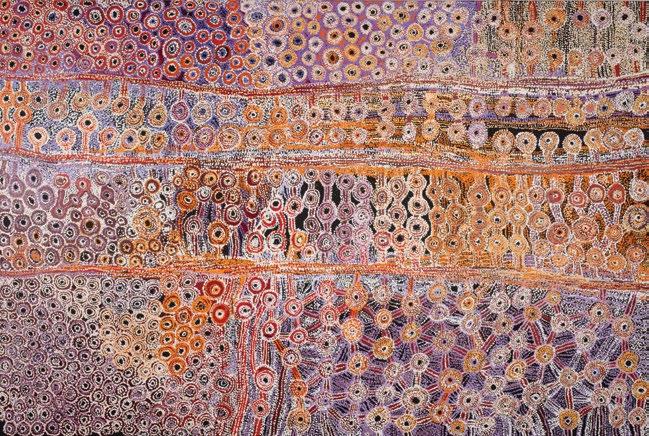
APY Galleries, Adelaide Studio, SA, Cat No. 1-21AS Private Collection, Vic
Accompanied by a certificate of authenticity from APY Studio Adelaide
‘Yaritji Heffernan was born in 1955 at Mulga Park Station near Pukutja in the far north-west of South Australia. Her parents were both Pitjantjatjara; her father was from Angkatja and her mother was from Umutju. She moved to Adelaide in 2010.
The circles of this design represent rock holes where water collects after rain. These rock holes have been an important source of water during the dry season when most of the waterholes and creeks dry up. Water is an essential element in the desert and the knowledge of rock hole sites containing ‘living’ water is passed on from generation to generation and revered by all Pitjantjatjara Aṉangu people.’*
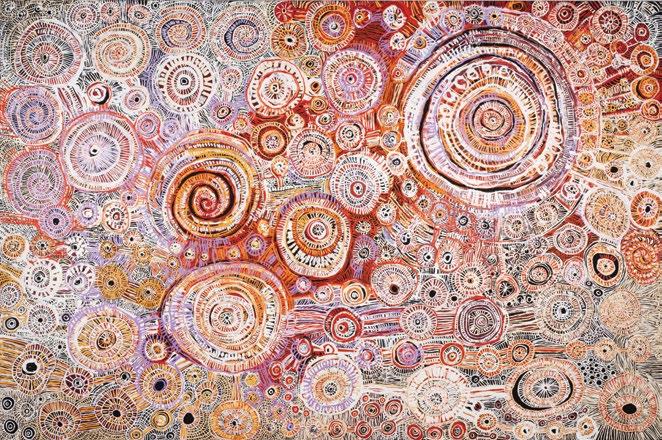
WIPU, 2015 181 x 305 cm synthetic polymer paint on Belgian linen EST $80,000 - 100,000
Yanda Aboriginal Art, NT, Cat No. TW201547 Private Collection, France Private Collection, NSW
Accompanied by a certificate of authenticity from Yanda Aboriginal Art and images of the artist working

Pitjantjatjara elder Tommy Watson gained wide acclaim in an astonishingly short amount of time. His first works were created at the community arts centre in Irrunytju, 12 km south-west of the tri-state border where the Northern Territory, Western Australia, and South Australia meet. This was just 44 kms east of Anamarapiti, where he was born c.1935. Though he recalled visiting Papunya in his youth, and observing the birth of the art movement there, he did not take up painting for another 30 years.
His debut at the 2002 Desert Mob exhibition in Alice Springs was followed by his participation in a series of group exhibitions from which his reputation gained momentum. His prominence as an artist of the highest renown was

ultimately cemented when, in 2006, he was commissioned to create a permanent installation at Musée du Quai Branly, in Paris.
Grounded in his paintings are rockholes, mountain ranges, creek beds, and important Dreaming sites created, according to the mythology of the region, during the major battle that took place between the White Cockatoo and the Eagle. In keeping with the depiction of Dreaming stories throughout the Western Desert, the landscape is rendered sacred and numinous through the actions of these mythic creator beings during its formation.

Naata Nungurrayi was about 30 years of age when she encountered the ‘welfare patrol’ in 1963, who forced her and her family to Papunya. She began painting for Papunya Tula Artists in 1996. Forced to leave behind her beloved desert homelands, the memory of these places and the life she led, has provided the inspiration and the subject matter for her highly sought-after paintings.
Naata’s paintings combine the carefully composed geometric style that developed at Papunya amongst the Pintupi painting men, with the looser technique and more painterly organic style introduced by the women after the painting camps of the early and mid 1990s.
This work depicts designs associated with the rockhole and soakage water site of Marrapinti, to the west of the Pollock Hills in Western Australia. The lines are sandhills surrounding the area, and the roundels represent rockholes.
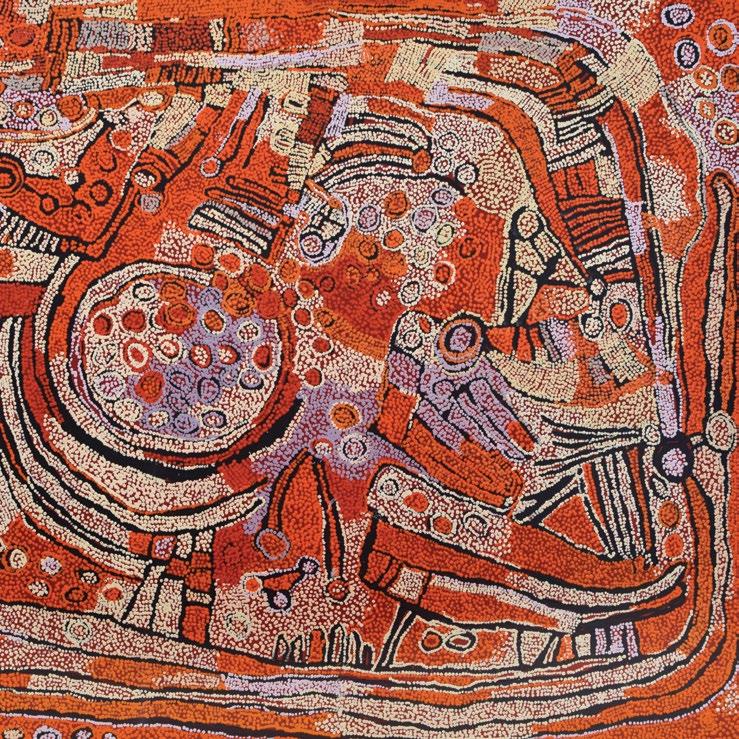
NINGURA NAPURRULA (c.1938 -
WOMEN’S DREAMING, 2006
x 122
polymer paint on Belgian linen
$16,000 -
PROVENANCE
Papunya Tula Artists,
Collection,
Cat No. NN0611038
Accompanied by
of
from Papunya Tula
-
THE ROCKHOLE SITE OF YUMARRA, 2000
polymer
x 122
on Belgian linen
$9,000 -
PROVENANCE
Papunya Tula Artists,


collection,
Cat No. NN0009131
Accompanied by a certificate of authenticity from Papunya Tula Artists
EXHIBITED
The Corrigan Collection, SBS Studio’s,
- 2021,
QUEENIE MCKENZIE NAKARA (1915 - 1998)
LIMESTONE COUNTRY - OLD TEXAS, 1994 61 x 76 cm; 64.5 x 80 cm (framed) natural earth pigments on canvas
EST $12,000 - 17,000
PROVENANCE Neil McLeod Fine Art, Vic Private Collection, VicQueenie McKenzie was born c.1930 at the Old Texas station, on the Ord River in the north-west of Western Australia. As a young girl, she cooked for the stockmen, tending and riding horses and journeying as they drove cattle across the vast pastoral region of the north.
In the 1970s, the establishment of the Warmun community drew her tribe together once more, becoming a cultural focal point within the Kimberley area. Queenie played a leading role in restoring her people’s culture and working toward a secure future. Involvement in community affairs led her to experiment with representational art as an educational tool in the local school, where she taught Gija language and cultural traditions. She was encouraged to paint her first artistic experiments by Rover Thomas, with whom she had worked in the stock camps for much of her life.
This painting demonstrates her strong love and attachment to country. Here, Queenie has painted the rocky hills on the edge of the desert plain in the country of her childhood and early working life near Old Texas Downs cattle station.
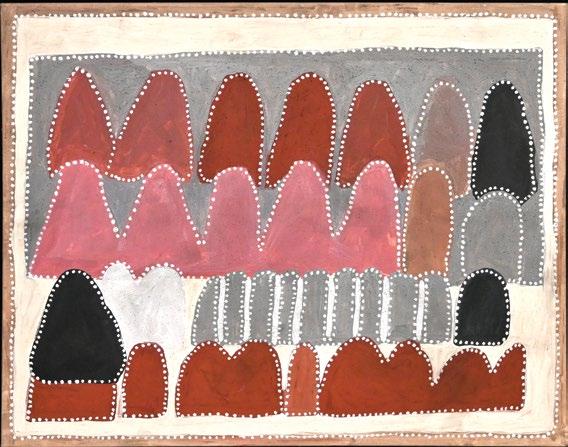
Delmore Gallery, NT, Cat No. 93A088
The Thomas Vroom Collection, The Netherlands Private Collection, Vic
Accompanied by a certificate of authenticity from Delmore Gallery
Olsen Irwin Gallery, Emily Kngwarreye, Paintings and Prints from the Thomas Vroom Collection, 2016, Sydney, NSW

In this highly dramatic work, the application of pink, yellow, and grey colours highlight the varied and changing hues in the lifecycle of the Anooralya Yam and the seasonal change that comes when storms build and bring rain to the the dry desert landscape near Alalgura on Utopia Station, west of Delmore Downs.
This work evokes the build up of an approaching storm.The rain falls and water slowly flows along the broad shallow watercourse and replenishes the soakage at Alalgura. The flourish of growth that follows is exceptional and rapid. The dramatic transformation of the desert from bare to abundant is a display of the desert’s power. Linked into this is women’s ceremonial life called ‘awelye’ that is based on the belief that they help nurture the desert food sources by ensuring future fertile generations.
51
REGINA WILSON (1948 - )
SYAW-FISH NET, 2004 120 x 201 cm synthetic polymer paint on Belgian linen
EST $20,000 - 25,000
Agathon Gallery, NSW, Cat No. 39
Cooee Art Gallery, NSW
Jeffrey Moose Gallery, USA Private Collection, USA
Accompanied by a certificate of authenticity from Agathon Gallery
Regina Pilawuk Wilson was born in 1948 in the Daly River region of the Northern Territory. In 1973, together with her husband Harold Wilson, she founded the Peppimenarti community as a permanent settlement. The location of the community is an important Dreaming site situated amid wetlands and floodplains at the centre of the Daly River Aboriginal Reserve, 300 kilometres south-west of Darwin.
The subject matter of Wilson’s works is based around the practice of weaving fibre art – a skill she inherited from her grandmother and mother.

YANNIMA TOMMY WATSON (c.1935 - 2017)
101 x 112 cm; 103.5 cm x 114.5 cm (framed) synthetic polymer paint on Belgian linen
EST $20,000 - 30,000
Yanda Aboriginal Art, NT Cooee Art, NSW Private Collection, NSW

Pitjantjatjara elder Tommy Watson was born at Anamarapiti, 44 kms west of Irrunytju (also named Wingellina), located 12 kms south-west of the tristate border where the Northern Territory, Western Australia, and South Australia meet. Though he recalled visiting Papunya in his youth, it was not until later that he himself felt compelled to lay down his stories in paint.
His debut at the 2002 Desert Mob show in Alice Springs was followed by his participation in a series of domestic group exhibitions, where his reputation gained rapid momentum. His prominence was ultimately cemented when, in 2006, he was commissioned to create a permanent installation at the Musée du Quai Branly, in Paris.
Grounded in his paintings are rockholes, mountain ranges, and creek beds. In this work he has depicted an important meeting place for hunting and camping with family members.
MINNIE
AWELYE
Dacou Gallery, SA, Cat No. 06321 Private Collection, SA
Accompanied by a certificate of authenticity from Dacou Gallery
The manner in which Minnie Pwerle created her works was the result of an urgency to reconnect to the past and to keep the Dreaming a living reality. Painting after painting depicts the body designs applied to women’s breasts and limbs for the regular ceremonial revivification of her country.
These bold linear patterns of stripes and curves evoke the movement of the women as they dance during ceremony. After smearing their bodies with animal fat, they trace these designs onto their breasts, arms, and thighs, singing as each woman has a turn to be ‘painted up’. Then, often by firelight, they dance in formation accompanied by ritual singing. The songs relate to the Dreamtime stories of ancestral travel as well as plants, animals, and natural forces.
Awelye-Women’s ceremony demonstrates respect for the land. In performing these ceremonies, they ensure well-being and happiness within their community.
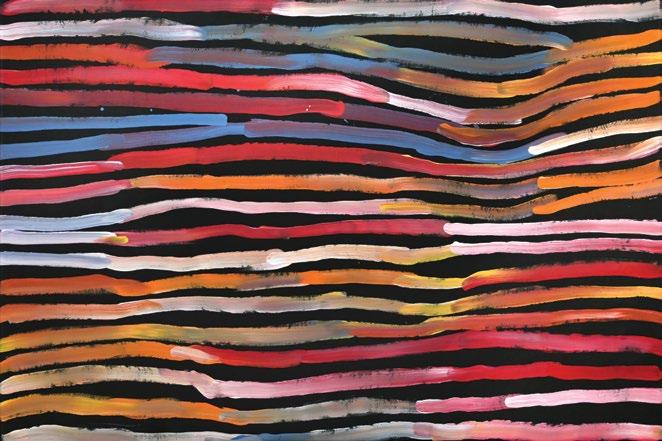
MRS P. NGAL (1936 - 2022)
BUSH PLUM COUNTRY, 2003 200 x 200 cm synthetic polymer paint on Belgian linen
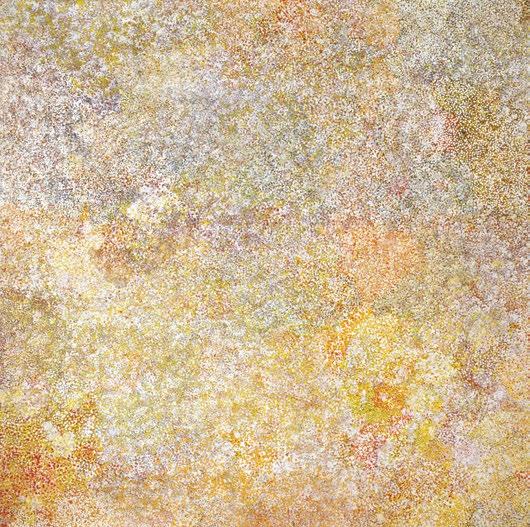
EST $15,000 - 20,000
Urapunja Artists, Utopia, NT Simon Turner International, NSW, Cat No. STI - 07302 Woolloongabba Art Gallery, Qld Cooee Art Gallery, NSW Private Collection, USA
At the time of her death in 2022, Ngal belonged to the oldest living generation of Utopia women and ranked amongst the most accomplished painters to have worked there during the past 20 years. Like many others, including Emily Kame Kngawarrye and Gloria Petyarre, Polly began her career in late 1979 creating images in Batik, prior to the introduction of painting on canvas in the late 1980s.
Ngal’s paintings often depict bright yellow seeds, a feast for emus, amongst the Bush Plums that grow in her country. Her paintings are borne from traditional knowledge and her confident approach to painting could be seen in the way she assembled streams of seeds, piling dots upon each other to create rich, thick fields by employing glowing palettes of colour. Her subject matter was always drawn from acute observation and memory, intimate knowledge of country, personal history, and ancestral journey. Seamless in her portrayal of these elements, her legacy consisted of sensory mind maps that revealed her place, her sense of self, and her world view.
EMILY KAME KNGWARREYE (1910 - 1996)
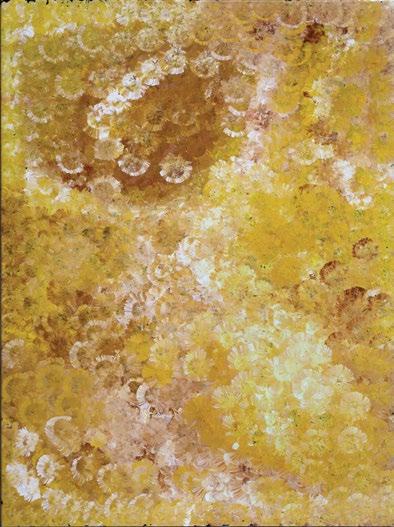
MY COUNTRY, 1995
x 90 cm; 125 x 92.5 cm (framed) synthetic polymer paint on Belgian linen
Commissioned by Rodney Gooch for Utopia Art, NT Utopia Art, NSW
The Thomas Vroom Collection, The Netherlands
Olsen Irwin Gallery, NSW Private Collection, Vic
EXHIBITED
Olsen Irwin Gallery, Emily Kngwarreye, Paintings and Prints from the Thomas Vroom Collection, 2016, Sydney, NSW
Reflected in this work is the Anooralya Yam, the most important plant in Emily’s custodianship. This hardy and fertile plant provides both a tuber vegetable and a seed bearing flower called Kame (Emily’s tribal name).
Emily’s use of yellow dramatically indicates a strong presence of the Kame’s daisy-like flowers, with her rapid double-dipping brushwork celebrating the presence of food underground. Ceremony has ensured that good seasons have returned due to the role Emily and her clanswomen have played in ‘growing up’ the food and human sources through their ceremonial activities.
We also look at this exciting work as a water catchment area. The rain falls and water slowly flows along the broad shallow watercourse and replenishes the soakage at Alalgura. The flourish of growth that follows is exceptional and rapid. Ceremony reinforces through the verses of the song cycle, the significance of this knowledge. In particular, it teaches survival, basic social codes, and obligations.
Warlayirti Artists, WA, Cat No. 457/08 Gallery Gondwana, NT, Cat No. CRP-EN457 Private Collection, NT

Accompanied by a certificate of authenticity from Warlayiriti Artists, and Gallery Gondwana
Elizabeth Nyumi was foremost amongst the second-generation Balgo Hills artists, on whose success the Warlayirti art centre at Balgo Hills after the late 1990s. More than any other, she carried on and extended the reputation of the Balgo women artists with her refreshingly distinct and individual depictions of the country of her family.
Parwalla was her father’s country. It is a large, swampy area dominated by sandhills that lies far to the south of Balgo Hills in the Great Sandy Desert near Kiwirrkurra. After the wet season Parwalla fills with water and becomes abundant with bush foods. These include bush raisins (kantiliyi), bush tomatoes (Pura), and a variety of seeds (Minyli). Men and women collect the bush raisin together. It is high in protein and is thought to have beneficial healing properties, especially for women. Uniting all of these important bush foods, Elizabeth employed various shades of yellow and white paint to depict the surrounding Spinifex grass, which grows strong and seeds after the wet season.
Utopia Art, NT, Cat no. Ekk435 Hank Ebes Collection, Vic
Accompanied by an image of the artist creating the artwork
Signed verso
Alatyite is a common form of bush tucker in the Eastern Desert region of Central Australia. At Utopia, this small, spiky bush with spinifex-like characteristics, contains within its root system long tubers which are collected by the women and taken back to the camp where they are cooked and eaten. Alatyite is narrow in shape and reaches up to 15cm in length.
This is a fine example of Emily painting in anticipation of the completion of ceremonies being held in her country, Alalgura, during the summer of 1994. Many of her greatest paintings were created during the ceremonial season as women dance to ensure that there will be abundance during the year ahead.
Widely regarded as Australia’s most important and successful Aboriginal artist, Emily Kngwarreye’s remarkable career lasted just 7 years until her passing at 86 years of age. The stylistic originality of her works changed almost monthly throughout this period and she extended her influence far beyond the reach of Aboriginal art, attracting an international audience. Since her death in 1996, her renown has continued to grow through retrospective exhibitions in Australia, Japan, the United States and Europe. Her painting Earth’s Creation I sold in 2017 for $2,100,000, the highest amount ever paid for a painting by an Australian female artist.
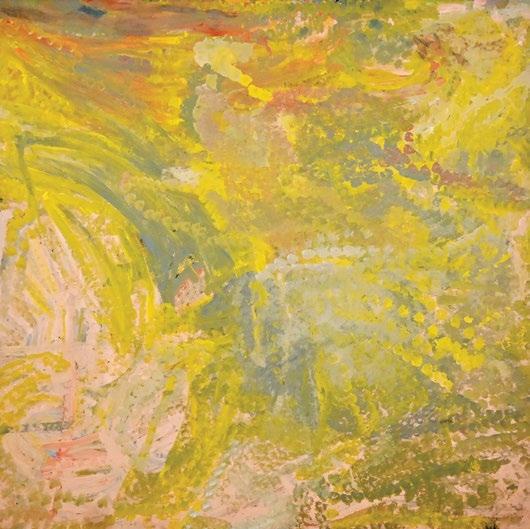
MURKARKI - BUSH PLUM, 2008
255.5 x 145 cm synthetic polymer paint on canvas
EST $6,000 - 9,000
Japingka Aboriginal Art, WA, Cat No. LNF346/Jap001238 Private Collection, Vic
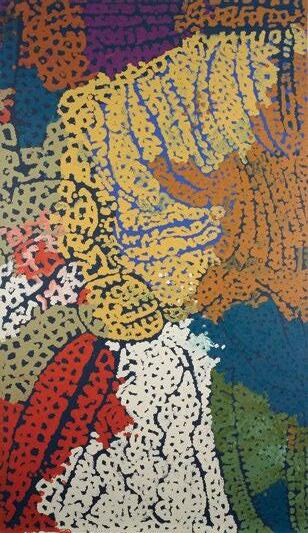
Accompanied by a certificate of authenticity from Japingka Aboriginal Art
Born at Yarturlu Yarturlu, a Yam Dreaming site in the Tanami Desert, Lorna Fencer was the custodian of inherited land Yumurrpa situated near Chilla Well, south of the Granites Mine. Her father’s country was Wapurtali. She spent her early years living a traditional life, until in 1949 she, along with many of her Warlpiri countrymen, were forcibly transported to the government settlement of Lajamanu at Hooker Creek, situated in the country of the Gurindji people. Here, many songlines cross over one another and at their points of intersection, each Dreaming becomes implicated in another.
59
WEAVER JACK (c.1928 - 2010)

LANGARUNG, 2007 183 x 66 cm synthetic polymer paint on canvas
EST $8,000 - 10,000
Short St Gallery, WA Cat No. 10853
Gallery Gondwana, NT, Cat No. 10425WJ
Private Collection, NT
Accompanied by a certificate of authenticity from Gallery Gondwana
Weaver Jack was born south of Well 33 on the Canning Stock Route in the Great Sandy Desert, Western Australia. She was forced to migrate from there in the late 1960s with her husband and children in search of food and water. They eventually settled on the coast at the old La Grange Mission now called Bidyadanga, where she began painting in her senior years.
Iwantja Arts, SA, Cat No. 397-19
Alcaston Gallery, Vic, Cat No. AK22022
Private Collection, Vic
Accompanied by a certificate of authenticity from Iwantja Arts, and Alcaston Gallery
‘Nangu artist Tiger Yaltangki was born in Pukatja (Ernabella) in 1973 and lives in Indulkana on the Aṉangu Pitjantjatjara Yankunytjatjara (APY) Lands in the remote north-west of South Australia.
A compulsive drawer and mark-maker, Tiger often pops up in his own paintings as a benevolent floating head with pointed ears. He actually appears twice here, upside-down at the top left-hand corner and in miniature in the lower-right. Other characters in his compositions – like the two-faced skeleton and dinosaur – are sometimes references to the Aṉangu concept of mamu (spirit beings) and sometimes pure imagination, just for the fun of it.
Yaltangki’s vibrant and prolific artistic output is closely informed by his love of music, and he paints to an eclectic soundtrack spanning from Creedence Clearwater Revival to country crooners to local desert reggae. One constant is the hard rock of AC/DC, who frequently figure in his work via their distinctive logo and electric guitar. All of these elements are drawn into Yaltangki’s whimsical visual universe in a joyous celebration of paint on canvas.’*
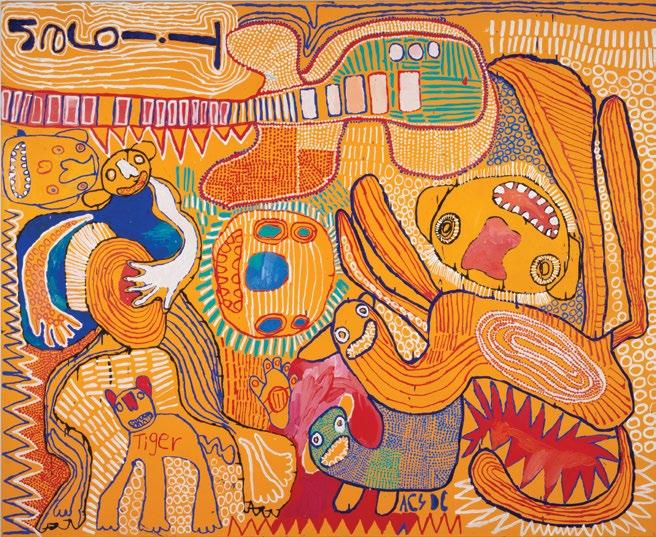
MYILILI, 2011
121.5 x 121.5 synthetic polymer paint on Belgian linen
EST $14,000 - 18,000
Papunya Tula Artists, NT, Cat No. PT1112050 Gallery Gabrielle Pizzi, Vic Niagara Galleries, Vic Private Collection, NSW

Accompanied by a certificate of authenticity from Papunya Tula Artists
Niagara Galleries, Blue Chip XVII; The Collectors Exhibition, 2015, Melbourne, Vic
Patrick Tjungurrayi was born near Jupiter Well and walked into the Old Balgo Mission that was established in 1943. After the community moved to its current location in 1962, he worked constructing the church and other buildings. He painted for Warlayirti Artists until the early 1990s, when he moved once more to settle in Kintore. He subsequently painted for Papunya Tula Artists until his death in 2017.
This work depicts a site in the Western Desert associated with the mythologicalTingari beings who travelled over vast stretches of the country, performing rituals and creating and shaping particular sites.TheTingari Men were usually followed by Tingari Women and accompanied by novices.Their travels and adventures are enshrined in a number of song cycles. These mythologies form part of the teachings of post-initiatory youths, as well as providing explanations for contemporary customs.
Yanda Aboriginal Art, NT, Cat No. WAL200219

Aboriginal Gallery of Dreamings, Vic, Cat No. 9230 Private Collection, Vic
Accompanied by a booklet of authenticity from Aboriginal Gallery of Dreamings and images of the artist working and with the completed work
Walala Tjapaltjarri, brother of well-known painters Warlimpirrnga and Thomas Tjapaltjarri, was born in the Gibson Desert east of Kiwirrkurra in the early 1960s.
In 1990, Walala watched in admiration and respect as his brother Warlimpirrnga began to paint. Shortly thereafter, he took to painting with the assuredness of a young man firmly grounded in his culture and intimately familiar with the sites he depicted. His subject from the outset was that of the Tingari cycle associated with a number of related sites in his country including Marua, Minatarnpi, and Mina Mina in the Gibson Desert of Western Australia.
Having developed his style during the early 1990s,Walala produced a work on canvas in 1997 that was unlike anything he had done before. Strongly gestural and boldly graphic, it featured roundels, rectangles,and abutting lines set against a stark monochrome black background.This distinctive and individual style laid the foundation for the remarkable body of work that he has completed since that time.
THREE SPIDER DREAMING, 1974 51 x 25.5 cm synthetic polymer paint on canvas board
EST $10,000 - 15,000
Purchased from John Jameson (general store manager), 1974, Papunya, NT Private Collection, Vic Christie’s, Australian and European Paintings, Lot 268, Melbourne, December 1994 Private Collection, Vic
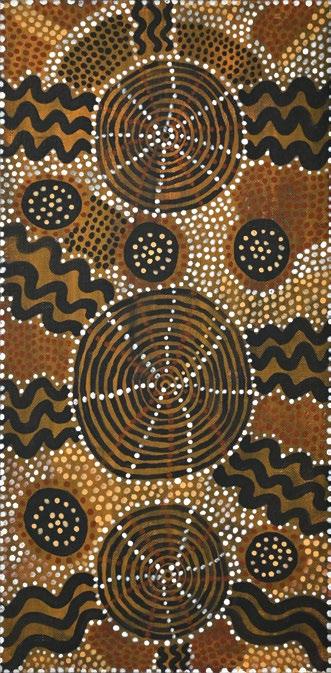
Inscribed verso with description of iconography
On loan to the Art Gallery of NSW, 1996-1999, Sydney, NSW
Johnny Warangkula was born at Mintjilpirri, north west of the Kangaroo Dreaming site of Ilpili soakage. He first encountered ‘whitefellas’ at just 12 years of age, and moved to Papunya with his first wife in the early 1960s, shortly after the community’s establishment. By the time Geoff Bardon arrived in 1971, he was a member of the Papunya Council alongside Mick Namarari.
Warangkula was amongst the most inventive of the early Papunya artists. His works at the time, according to Bardon, were distinguished by his ’calligraphic line and smearing brushwork’ that traced the movements of a journey, and picked up on the rhythmic recall of a mythic narrative.
During his first 15 years as a painter, he was foremost amongst those who fundamentally shaped the Papunya art movement. Choosing to keep within the hues of traditional earth-based ochres, Warangkula achieved a startlingly powerful statement of the earth, his country, and the life within it in his early paintings.
The Spider Dreaming west of Central Mt. Wedge and north east of Sandy Blight Junction is associated with Water Dreaming and Rain at Kalipinypa, a recurrent theme in Warangkula’s work. Spiders come out after rain to hunt for food. Central circles are spider holes, radiating lines are tracks made by the spiders. According to anthropologist Dick Kimber ‘The central circles mark nguru (the “sit-down place”) of the spider. At night these spiders can be heard; they make a noise like a calf cut off short on bellowing. (Kimber, 1976: 27)
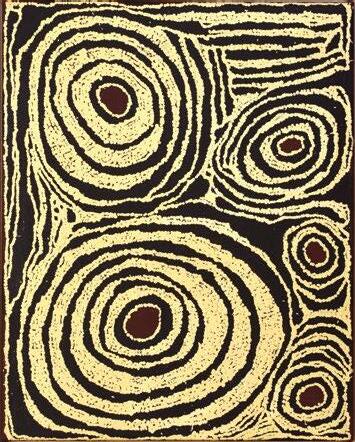

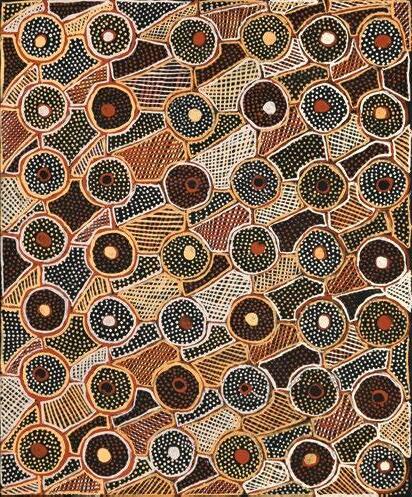

Jilamara Arts & Crafts, Melville Island, NT, Cat No. 36-02
Aboriginal and Pacific Art, NSW
The Collection of Milton and Alma Roxanas, NSW Bonham’s,The Roxanas Collection Of Aboriginal Art, Lot 167, Sydney, May 2014 Private Collection, NSW
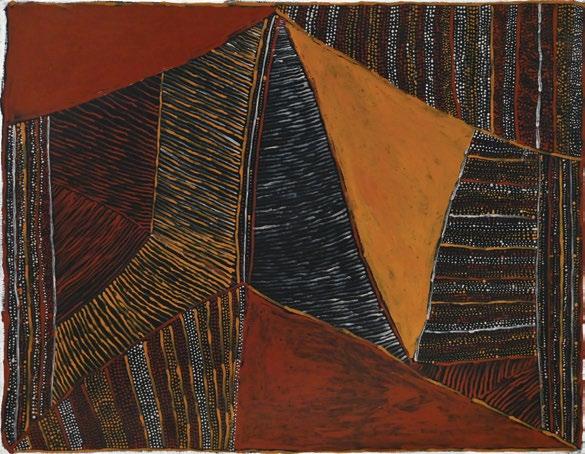
Kitty Kantilla’s art, and indeed all Tiwi art, is informed by the ornate body painting of the Pukumani ceremony. What makes the art of Kitty Kantilla and those of her generation so inherently important is the fact that the meaning of these designs has been largely lost since the missionary era. She was amongst the very last who inherited them intact.
A seemingly abstract iconography lies at the heart of Kitty Kantilla’s art. Far from being non-representational, the different combinations of dots, lines, and blocks of colour called jilamara (design), when combined, evoke elements of ritual and reveal the essence of Kantilla’s cultural identity. Like other Tiwi artists, Kantilla gained her artistic knowledge in ceremonial contexts, before learning to express her individuality by carving and painting objects related to the Pukumani (mourning) ceremony.
Her artworks, regardless of medium, were always tied to the fundamental Tiwi creation story. Bima, the wife of Purukapali, makes love to her brotherin-law while her son Jinani, left lying under a tree in the sun, dies of exposure. Purukapali becomes enraged and, after his wife is transformed into a night curlew, begins an elaborate mourning ceremony for his son. This was the first Pukumani (mortuary) ceremony, telling how death first came to the Tiwi Islands.
Mangkaja Arts, WA, Cat No. 279/06
Private Collection, Vic
Cory Surprise was born at Tapu, her father’s country, in the Great Sandy Desert. Though her parents both died there when she was still a baby, Cory stayed with her extended family until she walked out of the bush as a young woman having already been inducted into the law. As a result, she knew her country intimately, including all the places to find water, all the significant sites, and how to find food.
In time, she met and married the well known artist Peter Skipper, who worked as a contractor building fences. They travelled together and she worked as a camp cook and goat herd. They worked on stations throughout the Kimberley region before settling at GoGo Station (near Fitzroy Crossing) for more than 20 years.
Cory first started painting at Karrayili Adult Education Centre in the early 1980s when in her 50s. This work depicts Jilji (sandhills) at her birthplace deep in the Great Sandy Desert.

Warlayirti Artists, WA, Cat No. 168/99
Private Collection, Vic
Accompanied by a certificate of authenticity from Warlayirti Artists
Eubena Nampitjin began painting in 1988 alongside her second husband Wimmitji Tjapangarti. Their early works portrayed Dreaming sites, country and ancestral travels in the most intimate cartographic detail and are to this day the very finest paintings that have ever emanated from the Balgo Hills community.

After the death of her daughter Ema Gimme Nungurrayi in 1993, Nampitjin returned to her birthplace near Well 33 on the Canning Stock Route and did not paint again until encouraged to return to Balgo Hills two years later. From that time on she painted alone with larger, freer dots and a more gestural style executed with a palette of red, yellow and pink. In time these late career works became more akin to finger painting with fluid brushstrokes and only the occasional intimate section actually dotted with a stick.
Nampitjin’s work, with its trademark use of vibrant colour, bold patterning, and rough and ready handling, creates an ‘extraordinary sense of presence as in this rendition of her country along the middle stretches of the Canning Stock Route, near Kunawarritji (Well 33). This is the place where Nampitjin would often hunt and gather food. The strong lines in the painting depict the tali (sandhills) that dominate this country surrounding a hill named Yilpa.
ELIZABETH NYUMI
(1947 - 2019)
PARWALLA, 1998
120 x 180 cm; 123 x 182.5 cm (framed) synthetic polymer paint on Belgian linen
EST $10,000 - 15,000
Warlayirti Artists, Balgo Hills, WA, Cat No. WA415/98
Christie’s, Modern Australian Aboriginal Art, Lot 63, Sydney, October 2004 John Gordon Gallery, Steve Bush Collection, NSW Private Collection, NSW
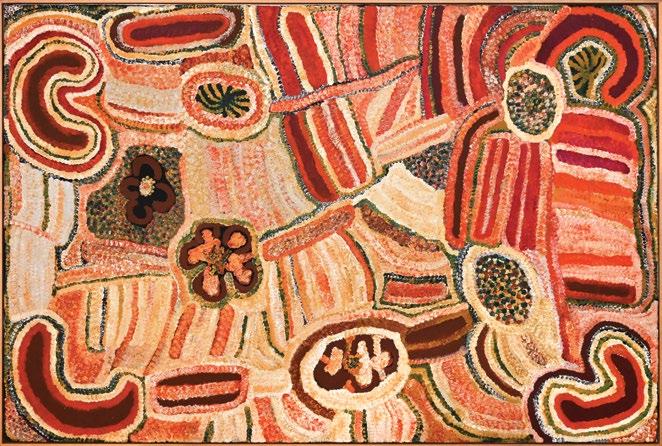
Accompanied by a certificate of authenticity from Warlayirti Artists
Elizabeth Nyumi’s early years were spent some 300 km south of Balgo, near Jupiter Well, where she lived a nomadic life until she walked up the Canning Stock Route and into the old Balgo Mission in her late teens. She began painting in acrylics for the Warlayirti Art Centre in 1988.
This painting depicts the country known as Parwalla, which is Nyumi’s father’s country far to the south of Balgo in the Great Sandy Desert, west of Kiwirrkurra. Parwalla is a large swampy area that fills with water after the wet season and consequently produces an abundance of bush foods. The majority of Nyumi’s paintings show the different bush foods, including kantjilyi (bush raisin), pura (bush tomato), and minyili (seed). The whitish colours represent the spinifex that grows strong and seeds after the wet season rains.
BOXER
Warlayirti Artists, WA, Cat No. 192/02 Cooee Art Gallery, NSW Private Collection, NSW
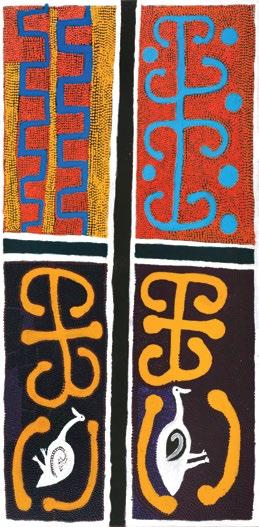
Accompanied by a certificate of authenticity from Warlayirti Artists
Cooee Aboriginal Art Gallery, Way Out West, 2006, Sydney, NSW Shalom, Shalom Institute UNSW, 2008, Sydney, NSW
Boxer Milner was a senior Law man who, along with his two brothers, were custodians of the desert country around the middle and upper stretches of Sturt Creek in the Kimberley. His images invariably depicted the creek, and surrounding country during flood, and after floodwater recedes.
The area of Milnga-Milnga is a major flood plain which is inundated every summer after the rains. Boxer’s paintings show tributaries and the ‘milk water’ that runs after rain has fallen in the clay soils upstream of Billiluna. His work includes the depiction of rainbows, rain clouds, and the temporary creeks that are formed during the wet season. As a younger man, Boxer worked around this area as a stockman, and gained an intimate knowledge of this country.
DILLY BAG, c.1960
50 x 21 x 19 cm (irregular) woven Pandanus fibre and natural earth pigment
EST $1,200 - 1,500
Field collected, Millingimbi Region, NT Private Collection, NSW
Dilly bags have diverse uses, both practical and spiritual. In many paintings they represent ancestral beings.This item is woven from twined Pandanus fibre, and has been painted in earth pigment with alternating bands of colour, creating an unusual vibrancy.
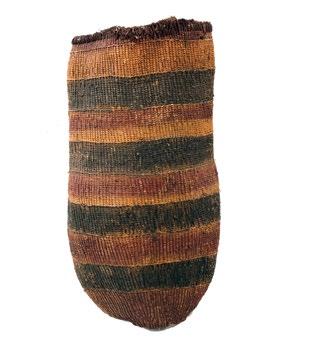
EARLY SHIELD WITH FIRE TOOL MARKINGS, c.1900
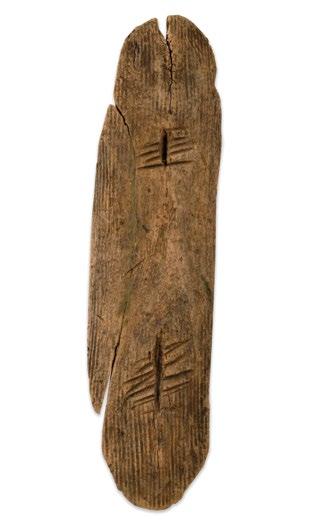
69 x 18 x 4 cm (irregular) carved Beanwood with natural earth pigments
EST $1,500 - 2,500
Field collected, Central Desert Region, NT Private Collection, SA Private Collection, NSW
Carved Beanwood (with custom stand). Handle carved from solid form level with anterior surface. Evidence of continuous incised fluting on convex exterior surface.
WUNDA SHIELD, c.1900
76 x 18 x 5 cm (irregular)
carved hardwood and natural earth pigments
EST $3,000 - 4,000
Field collected, WA
Private Collection, NSW
With solid cut handle, incised decoration on both sides, the zigzag linear design emphasised by the application of ochre and pigments.
Shields were used as protective devices of both hardwood and softwood, and were generally used to deflect missiles and stop clubs.
Shields such as this however, were important ritual objects.
PAINTED BEANWOOD SHIELD, c.1960
70 x 23 x 6 cm (irregular)
Carved Beanwood with natural earth pigments
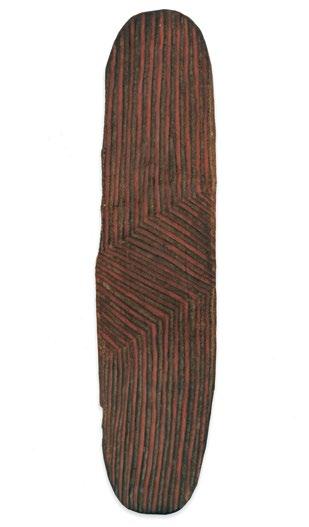
EST $1,500 - 2,500
Field collected, Central Desert, NT
Private Collection, NSW
Possessing a beautiful symmetry, shallow striated fluting of near perfect regularity. Coated in red ochre and further decorated in black and white pigment with the paw prints of the ancestral dingo shown in black surrounded with white dotting along with the path of its travels.

b.
PADDY WAINBURRANGA FORDHAM (1932 - 2006)
WADITJ AND BOLONG, c.1980 a. 63 x 19.5 cm and b. 73 x 30 cm natural earth pigments on bark

EST $2,000 - 3,000
Purchased from the artist c.1980, NT Private Collection, WA Private Collection, Qld
Paddy Fordham was the leader of the Rembarnga people and an artist of great renown whose career was notable for a number of major episodic works. In these two paintings he depicts Bolong, the Rainbow Serpent and how Waditj - the Rock man, turned into stone.
The image of Bolong explains how Indigenous society is divided into two separate moieties and a number of different skin groups.
In the episodic bark that accompanies it, Waditj is shown living with his clan in the Wybalk country. He was a devil man - very cruel and greedy. One day he decided to fulfil his desire to create more havoc in the world. He told his people that he was leaving to see what he could take from the neighbouring tribes.
On his journey Waditj came to a billabong and could hear songs from the Wagilag Sisters Dreaming being sung by people of the Ngalbon clan. As he got closer he began to feel heavy and found it hard to move. Black stone-like lumps began growing all over his body.
Rembarnga people say that Waditj was punished for his evil and was turned into a rock by the Bolong (Rainbow Serpent), the most powerful spirit of all.
Yanda Aboriginal Art, NT, Cat No. PL200225 and PL200242 Private Collection, Vic
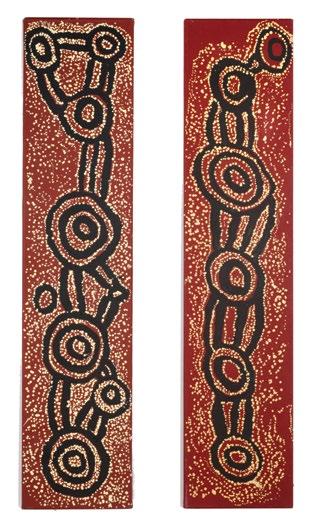
The Tingari Cycle is a secret song cycle sacred to initiated men. The Tingari ancestors travelled across the landscape visiting sites associated with Maliera (initiation) ceremonies. Today, these sites take the form of, and are located at, significant rockholes, sand hills, sacred mountains, and water soakages in the Western Desert. These works can be poetically interpreted as songline paintings relating to the songs (of the people) and creation stories (of places) in Pintupi mythology.
Pegleg is closely associated with his friend Pinta Pinta Tjapanangka. Both created works with economy of form and colour that came to symbolise a return to the scale and temperament of the early years of the Western Desert Art Movement.
DICKIE MINYINTIRI (1915 - 2014)
UNTITLED, 2007 89.5 x 60 cm synthetic polymer paint on Belgian linen
$5,000 - 7,000
Ernabella Arts Inc, SA, Cat No. DM254-07 Private Collection, NSW
Senior Anangu Law man, Dickie Minyintiri, was a respected healer and celebrated artist. He began painting in 2005 for Ernabella Arts Inc. at 90 years old. In 2011, he won the major prize at the Telstra National Aboriginal and Torres Strait Islander Art Awards at 98 years of age.
Minyintiri early life was spent travelling with his parents across the Anangu Pitjantjatjara Yankunytjatjara lands. When he and his family first came to Ernabella, they were the first people there, and were able to identify landmarks such as rocky waterholes, outcrops, and caves where his family camped. He also remembered the first ‘whitefella’ coming to Ernabella, the first building, and the entire establishment of the Ernabella Mission.

WILLI, 2004
Mangkaja Arts, WA, Cat No. pc109/04 Private Collection, NSW
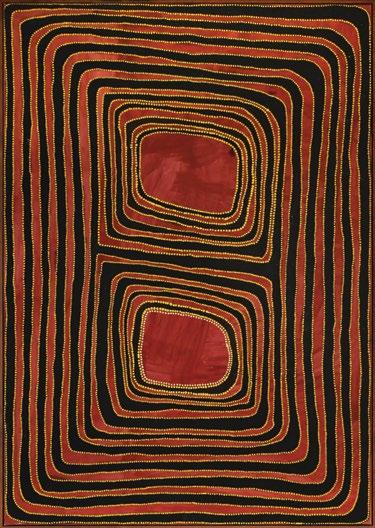
Accompanied by a certificate of authenticity from Mangkaja Arts
Signed verso
Jimmy Nerrimah was born at a swamp called Miyitinynanguwu, 500 km south east of Derby. He went through the law at Lumpu Lumpu and lived a nomadic existence in the desert until his 60s. As a fully initiated Walmajarri man, he knew all of the waterholes and soakages throughout his countr y. He lived in the desert, moving around totally reliant on these sources of water. He finally left the bush in his 60s and worked for a time at Nerrimah Station, where he got his ‘white fella’ name. In this work, he depicts a series of waterholes (jillas) on his country, Wayampajarti, in the north-western area of the Great Sandy Desert
TJUMPO TJAPANANGKA (1929 - 2007)
MEN’S LAW PAINTING -
SANDY DESERT,
x 79.5 cm
Warlayirti Artists, WA, Cat No. 315/98 Gallery Gondwana, NT, Cat No. 3957TT Private Collection, NT
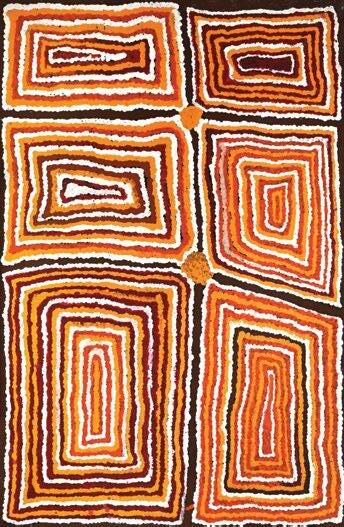
Accompanied by a certificate of authenticity from Warlayirti Artists, and Gallery Gondwana
At the time of his death in 2007 (the year this painting was created), Tjumpo Tjapanangka was Balgo’s most venerated male artist and the most highly regarded Law Man in the community.
In both his art and his personal demeanour, Tjumpo Tjapanangka affected an infectiously vivacious and animated style. It is this energy and confidence that he employed to build the resonating planes that characterised his finest works and brought such critical acclaim. His wife Ningie Nangala shared his preference for softer colours, and to some extent this aesthetic can be seen in the more recent paintings created by his stepdaughter, Elizabeth Gordon, to whom he passed on a number of his Dreamings.
In this work Tjumpo painted Kukurrpungku, close to the large salt lake, Wilkinkarra - Lake Mackay. The orange circles represent “living water”, or permanent water sources. Water pools here after rain, before draining back into sand. The majority of the painting depicts the tali “sand dunes” which dominate the landscape. This was especially important for Tjumpo as several of his family, including his uncle, died at this place.
Senior Anangu Law man, Dickie Minyintiri, was a respected healer and celebrated artist. He began painting in 2005 for Ernabella Arts Inc. at 90 years old. Ernabella art states: ‘Kapi Tjukula are the places Dickie and his family used to find water as they travelled across the APY Lands in precontact times. Dickie was born in the western APY Lands, and with his family, journeyed east, and camped for many years in the foothills of the Musgrave Ranges around Ernabella where water was plentiful. He was living here when the missionaries came in on camels to try and find a suitable place to set up a mission for Pitjantjatjara Yankanyutjatjara people. He is one of the few living Anangu that remember first contact. The lines connecting the circles (tjukula) represent Dickie and his family’s journey.’
This work continues the story of Minyintiri’s award winning work in the 98th Telstra National Aboriginal and Torres Strait Islander Art Awards in 2011, which he won at 98 years of age. The circles in this painting represent the many rockholes and clay pans that Minyintiri knew so intimately and his long overdue first survey show was received to critical acclaim in Melbourne in 2021.

-
1984
Papunya Tula Artists, NT, Cat No. CT840825
Joel Fine Art, Important Aboriginal Art, Lot 145, Melbourne, June 2007 Private Collection, Vic
Accompanied by a certificate of authenticity from Papunya Tula Artists
Charlie Tawara (Tararu) was a founding member of Papunya Tula and became an important spokesman for the Pintupi due to his strong command of English. He was noted as having been an adventurous and energetic man, and despite a number of white people in the settlement characterising him as difficult, Bardon found him to be accessible and loyal. His versatility with language and European customs enabled him to guide and explain, on both sides of the cultural divide. He was the eldest of the many Tjungurrayi skin ‘brothers’ that included Kingsley, Shorty Lungkata, and Yala Yala as well as Don, George, Willy, Two Bob, and Yumpululu who would follow these artists into painting.
This painting is sold with an accompanying certificate from Papunya Tula Artists that reads ‘the site depicted in this painting is tjitutulnga to the West of the Kintore community. This place is associated with the ninu (a small marsupial) Dreaming. There is a man and his two wives living at this site. The circles represent places in the hills where the ninu enter.’

Papunya Tula Artists, NT, Cat No. TJ820824

Aboriginal Gallery of Dreamings, Vic, Cat No. 7115
Private Collection, Vic
Accompanied by a booklet of authenticity from Aboriginal Gallery of Dreamings
John Kipara was born and grew up near Kulkuta, north of the present-day community of Kiwirrkurra. He spent his youth in salt lake country, southwest of Lake Macdonald, before his family became one of the first groups to be re-settled at Papunya in the early 1960s.
Shortly thereafter, he joined Anatjari Tjakamarra,Yala Yala Gibbs and Freddy West as a farm labourer and later became a founding member of the artist group that coalesced around Geoff Bardon in 1971.
Embracing the stories and designs of the Tingari cer emony and ancestors from the outset he became one of the mainstays amongst the Pintupi artists who produced this ‘classic’ iconography. His works of art were always simple yet powerful in their composition and executed in earthy ochre tones.
In this typical work by the artist roundels are linked by an intricate network of travelling lines reflecting the multiplicity of relationships between the land, the people, and their spiritual ancestors.
KUDDITJI KNGWARREYE (1938 - 2017)
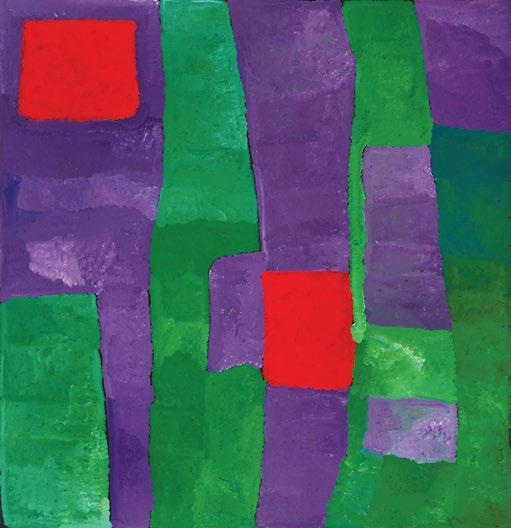
COUNTRY, 2006
x 190 cm
polymer paint on Belgian linen
$8,000 - 12,000
Aboriginal Gallery of Dreamings, Vic, Cat No. 11242 Private Collection, Vic
Accompanied by a booklet of authenticity from Aboriginal Gallery of Dreamings and an image of the artist working
The younger brother of the late Emily Kame Kngwarreye, Kudditji had a traditional bush upbringing in the Utopia region. Prior to painting, he had numerous jobs throughout the Central Desert as a stockman, and also worked in mineral and gold mines. He became a traditional custodian of many important Dreamings of the land and Men’s Business, as well as ceremonial sites located in his country at Utopia Station, about 230 km north east of Alice Springs.
He began painting symmetrical dotted paintings in the early 1980s, beginning to develop this highly intuitive and gestural style after seeing Emily catapult onto the Australian and International Art scene in the 1990s. Thereafter, his artworks became known for their bold colour use and intuitive interplay with space and form.
With a heavy loaded brush, he painted his country using broad strokes and a combination of bold colours and soft fusions, accentuating the natural colours of land and sky over various seasons. This painting depicts an interpretation of the Emu Dreaming site and ceremonies associated with Men’s Business.
Warlukurlangu Artists, NT, Cat No. 295/04 Private Collection, NSW

Accompanied by a certificate of authenticity from Warlukurlangu Artists
Born on Mt. Doreen Station, north-west of Alice Springs, circa 1925, Judy Watson grew up in the vast Warlpiri country that lies between the Tanami and Gibson deserts. Her traditional nomadic lifestyle came to an end, however, when the Warlpiri were forced to live in the new government settlement at Yuendumu.
Years later, following the birth of her ten children amid great struggles living under European colonisation, the influence of those early years in the land of her ancestors burst forth in her art. Her principal focus was the Women’s Dreaming of the Karnta-kurlangu – a large number of ancestral women who danced across the land, creating important sites, discovering plants, foods, and medicines, as well as establishing the ceremonies that would perpetuate their generative powers.
At Mina Mina, these ancestral women danced and performed ceremonies before travelling on to Janyinki and other sites as they moved east toward Alcoota. During their ritual dancing, digging sticks rose up out of the ground and the women carried these implements with them on their long journey east, singing and dancing all the way without rest. The hairstring is anointed with red ochre and is a secret and sacred connection between the women’s ceremony and the country, which enables them to connect with the spirit of the Dreaming.
87
ALMA WEBOU (c.1920 - 2009)
PINKARLATA, 2004
90 x 60 cm; 92 x 62 cm (framed) natural earth pigments on board
EST $3,000 - 5,000
Short St Gallery, WA, Cat No. 11151 Private Collection, ACT
Accompanied by a certificate of authenticity from Short St Gallery Alma Webou paints Pinkalarta, the home where both she and her mother grew up. It is located in the Great Sandy Desert near Joanna Springs on Anna Plains station. Her work gives an aerial view of the landscape, showing the mayi (bush food) and the jila (living water). Webou is a part of the Yulparija people who were forced to leave her home when the water began to dry up. She found her new home in the coastal town of Bidyadanga, and as a result, her desert imagery is expressed with the vibrant contrasts of the saltwater landscape.
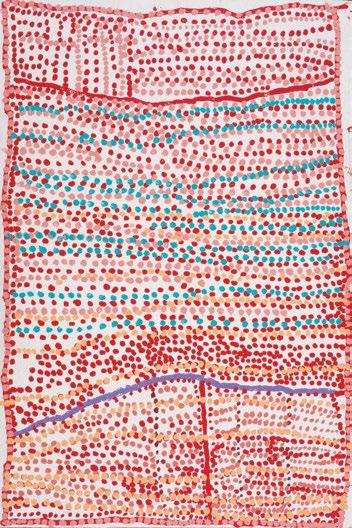
Short St Gallery, WA, Cat No. 11457 Private Collection, ACT
Accompanied by a certificate of authenticity from Short St Gallery
Jan Billycan was an important healer and medicine woman and highly respected elder amongst Western Desert people and in the communities of Broome and Bidyadanga, where she spent much of her late years.
The landscape and body-scape are continually merged in Billycan’s paintings. Her artworks raise issues of identity and the metaphysical nature of things, while playing on the idea that the land and self as one. Billycan’s paintings have the appearance of a naïve rawness that belies their emotional sophistication and her complex understanding of the physical world. She mixed colours directly on the canvas, working lines repeatedly until they achieved a density and unique hue that reflected the individuality of each single sand dune in the desert, or every single bone in the body.

89
129 x 197.5 cm synthetic polymer paint on canvas
EST $5,000 - 7,000
Tjungu Palya, SA, Cat No. 10112
Pat Corrigan Collection, NSW
Accompanied by a certificate of authenticity from Tjungu Palya
Jane Raffan, Power + Colour: New Paintings from the Corrigan Collection of 21st Century Aboriginal Art, Macmillan Publishing, 2012, p.226-227
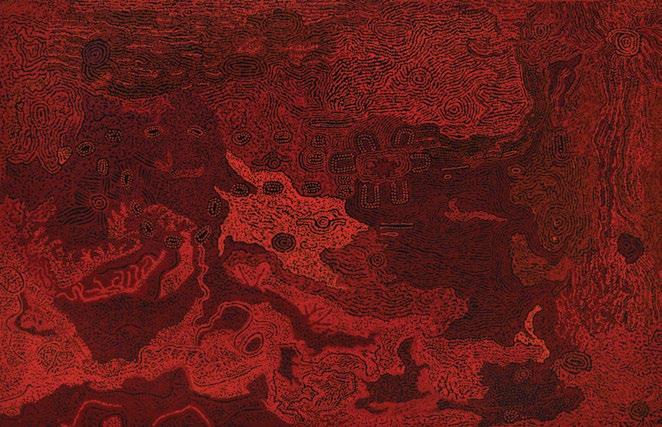
The Corrigan Collection, SBS Studio’s, 2012 - 2021, Sydney, NSW
Keith Stevens is a Pitjantjatjara artist born at Granite Downs Cattle Station in the far north of South Australia, where his parents were working in the 1940s. Mustering cattle from an early age, he had no schooling before moving to Pukatja (Ernabella) as a young boy where he attended the mission school.
Keith’s family would travel for weekends to their traditional homelands of Piltati and Iwarrawarra, eventually moving to Piltati creek at what is now Nyapari Community. His mother Eileen Stevens and his uncles Tiger Palpatja and Ginger Wikilyiri were all well known for their depictions of Piltati, the ancestral story for Nyapari.
PROVENANCE Aboriginal Gallery of Dreamings, Vic, Cat No. 11942 Private Collection, Vic

Accompanied by a booklet of authenticity from Aboriginal Gallery of Dreamings and images of the artist working
Kudditji’s paintings are romantic images of his country, accentuating the colour and form of the landscape. This painting is an interpretation of his Emu Dreaming site and the ceremonies associated with Men’s Business.
The younger brother of the late Emily Kame Kngwarreye, Kudditji had a traditional bush upbringing in the Utopia region. As he grew older, he became the traditional custodian of many important Dreamings in the country at Utopia Station, about 230 km north east of Alice Springs. He developed his highly intuitive and gestural style after seeing Emily catapult on to the Australian and International Art scene in the 1990s. Thereafter his artworks became known for his bold use of colour and the intuitive interplay of space and form in his works.
UNTITLED, 1996


x 61 cm
polymer paint on Belgian linen
$3,000 - 4,000
Papunya Tula Artists, NT, Cat No. TP9609142 Private Collection, NSW
Accompanied by a certificate of authenticity from Papunya Tula Artists
PIRLINYANU, 2020
x 106.5 cm
polymer paint on Belgian linen
$3,500 - 5,500
Warlukurlangu Artists, NT Cat No. 2766/20 Private Collection, Vic
Accompanied by a certificate of authenticity from Warlukurlangu Artists
Julie Robertson is the daughter of renowned painter Dorothy Napangardi. In this work she has rendered her fathers country around Pirlinyanu, a site made up of rocky outcrops on a stark black background enlivened with a tracery of white dots. This is an important permanent water source west of the Yuendumu community in the Tanami Desert.
PROVENANCE Gallery Gondwana, NT, Cat No. 13802DN Private Collection, NT
Accompanied by a certificate of authenticity from Gallery Gondwana
ILLUSTRATED
Gallery Gondwana, ‘Dorothy Napangardi’, NT, 2020, illustrated p.41
Regarded as one of the leading artists of the contemporary Aboriginal Art movement, Warlpiri artist Dorothy Napangardi painted Mina Mina, a highly significant site in the Tanami Desert, north west of Alice Springs. Creating her own unique language to describe these homelands, her paintings feature an interlacing network of dotted lines that form both a micro and a macro study of the land.These lines represent the salt encrustations around the dry clay pans etched with the tracks of the ancestral Karntakurlangu ancestors. (Karnta – means “women”, kurlangu – means “belonging”).

During the Jukurrpa (Dreaming), these women gathered to collect ceremonial digging sticks that had emerged from the ground from the desert oak trees (Allocasuarina decaisneana) which continue to grow today. They then proceeded east, performing rituals of song and dance, to the place known as Jankinyi.
In this artwork the artist has created a portion of the Jukurrpa (Dreaming) that depicts the ancestral women dancing around the soakages of Mina Mina and the encrustations that form when rainwater recedes; through the spinifex clumps and over the sand hills.
Gallerie Australis, SA, Cat No. GAAL02131658 Private Collection, NSW
Accompanied by a certificate of authenticity from Gallerie Australis
Grand Palais, Paris Art Fair, 2013, Paris, France Arts D’Australie Stephane Jacob, Arts D’Australie a la Barclays Banque Privee, Avenue George V, Paris, 2013-2014, Paris, France
Abie Loy was born on Utopia station, about 270 km north-east of Alice Springs in the Northern Territory. An innovative mid-career artist, Abie was mentored by her grandmother Kathleen Petyarre from the time she began painting at 19. Over the years, Abie further developed her skills as an artist to become an extraordinarily talented designer, experimenting with line, colour and form. In this painting, Abie depicts the part of the songline that leads to the ceremonial women’s site associated with the green pea (antweth), plant life found in her ancestral sandhill country

Aboriginal Gallery of Dreamings, Vic, Cat No. 11373 Private Collection, Vic

Accompanied by a booklet of authenticity from Aboriginal Gallery of Dreamings
Though Minnie Pwerle began painting in 1999, she joined her sisters in creating collaborative works when Emily, Galya, and Molly began painting in 2005. Minnie lived at Atnwengerrp, and could speak both Anmatjere and Alyawarra while her sisters lived at Irrultja to the north, and spoke only Alyawarra.
In this work, each of these artists painted in their own very distinct body design. While Minnie painted bold linear patterns of stripes, curves, and circular seed shapes, Emily painted more angular circles, triangles, and squares. Galya, meanwhile, painted kidney bean shapes, and Molly parallel lines. Each of these designs represent the body design associated with their individual Dreamings - the plants and seed that they were responsible for as part of their obligation to country, and which they represented in Awelye (ceremony).
TIGER PALPATJA (c.1920 - 2014)
WANAMPI CREATION STORY, 2005
101.5 x 101 cm; 104.5 x 104 cm (framed) synthetic polymer paint on canvas
EST $3,500 - 4,500
Minymaku Arts, NT, Cat No. 766-05
Private collection, NSW
Accompanied by a certificate of authenticity from Minymaku Arts
Jane Raffan, Power + Colour: New Paintings from the Corrigan Collection of 21st Century Aboriginal Art, Macmillan Publishing, 2012, p.202-203

The Corrigan Collection, SBS Studio’s, 2012 - 2021, Sydney, NSW
Though he began painting at the late age of 85, Tiger Palpatja’s colourful, lively compositions immediately attracted art world acclaim. His blood reds, delicate pinks, lilacs, and molten yellows impart a lovely gentleness to works renowned for strong lines and writhing serpentine forms.
Tiger was a senior custodian for the Wanampi creation story, which was central to his identity. It still instructs people in the reciprocal relationship between men and women to this day.
Papunya Tula Artists, NT, Cat No. JY0405141 Private Collection, SA
Accompanied by a certificate of authenticity from Papunya Tula Artists
JohnnyYungut was born in country north-east of Kiwirrkurra.At the time of his death he was the last surviving man of his generation. He began painting for Papunya Tula Artists in 1978 but moved away from Papunya and only resumed painting in 1991.
This painting depicts designs associated with the soakage water site of Tjungamunta, situated in an area of stony hills and abundant rocks northeast of the Kiwirrkurra community. In mythological times, a large group of Tingari Men travelled from the south-west, passing through Kiwirrkurra and Tjungamunta and then continuing farther north-east.

98
JAN BILLYCAN (1930 - 2016)
KIRRIWIRRI, 2007 90 x 60 cm; 92 x 62 cm (framed) raw pigment plywood
EST $4,000 - 6,000
Short St Gallery, WA, Cat No. 11059 Private Collection, ACT
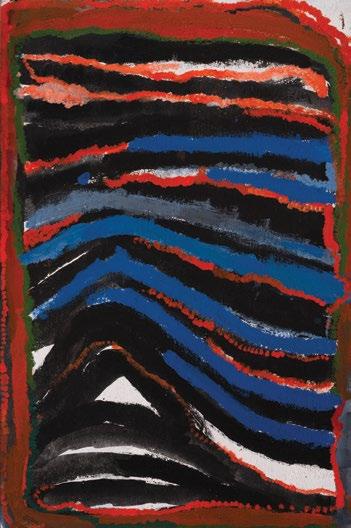
During the last years of her life, Jan Billycan (aka Djan Nanundie) depicted the country of her birthplace, Kirriwirri and other sites in Ilyarra country. This is a land of spreading mud flats, gleaming salt lakes and a life-giving network of freshwater springs with their source deep underground. It was the home of the Yulparija people, deep in the Great Sandy Desert, before drought and mining caused the environmental catastrophe that drove them to the coastal refuge of Bidyadanga south of Broome. Following a time of grief and exile a new art movement flourished and Jan, a respected Marpan, or medicine woman, became a leading light.
This painting, an expression of her unique and startling talent, depicts the birth place of her father’s clan. There is a big warla (mud flat) at this place in the Great Sandy Desert close to and west of Well 33 on the Canning Stock Route.
In 2011 Jan Billycan won the West Australian Indigenous Art Award at the Art Gallery of Western Australia in Perth.
UNTITLED, 1947 29 x 38 cm; 52 x 42 cm (framed) pastel on paper

EST $2,000 - 3,000
Singed by artist Merryn Smith
LOT 99 & 100
PROVENANCE
Private Collection, WA Private Collection, Qld
UNTITLED, 1947 29 x 38 cm; 52 x 42 cm (framed) pastel on paper

EST $2,000 - 3,000
The Carrolup School emerged in Western Australia as a distinctive landscape painting tradition created by school aged Aboriginal children in the 1940s.
Its elements of romantic depiction of the bush and bush life may well reflect the needs of the child artists who were removed from their Aboriginal families under government policy. The tradition became a shared style of painting as the young artists matured and painting techniques spread through family groups, creating a regional style in the wheat belt and south west towns of Western Australia.
MINNIE PWERLE (1910 - 2006)
AWELYE ATNWENGERRP, 2004 51 x 36 cm synthetic polymer paint on Belgian linen

$900 - 1,200
Dacou Gallery, SA, Cat No. DG05788
Flinders Lane Gallery, Vic, Cat No. FG04111 Private Collection, NSW
Accompanied by a certificate of authenticity from Flinders Lane Gallery
The bold linear pattern in this work evokes the movement of the women as they dance during ceremony. After smearing their bodies with animal fat, they trace lines onto their breasts, arms, and thighs, singing as each woman has a turn to be ‘painted up’. Then, often by firelight, they dance in formation accompanied by ritual singing. The songs relate to the Dreamtime stories of ancestral travel as well as plants, animals, and natural forces.
Mornington Island Arts and Crafts, NT, Cat No. 2550-L-SG-0907
Alcaston Gallery, Vic, Cat No. AK13873
Private Collection, ACT
Accompanied by a certificate of authenticity from Mornington Island Arts and Crafts
Dibirdibi Country conveys the story places of Dibirdibi, the Rock Cod ancestor, and charts his creative journey along the Bentinck Island coastline. These stories belonged to her late husband, Pat, whose traditional name was also Dibirdibi. This and other late-career paintings by Gabori are increasingly abstract in nature but retain certain representational elements crucial to mapping her country, including the prominent Kaiadilt rock-walled fish traps.
Neil McLeod Fine Art, Vic
Flinders Lane Gallery, Vic, Cat No. FG00502 Private Collection, Vic
Accompanied by a certificate of authenticity from Flinders Lane Gallery and an image of the artist with the completed work
During the last decade of her life, Patsy Lulpunda lived on the Prince Regent River near Mowanjum and created hair belts, stone axes, and other items of material culture. Her first paintings were created at the age of 100, whilst visiting the great Kimberley custodian and storyteller Jack Dale during a workshop organised in 1998. She participated in several painting workshops at his home before her death at 102 at the start of the millennium.
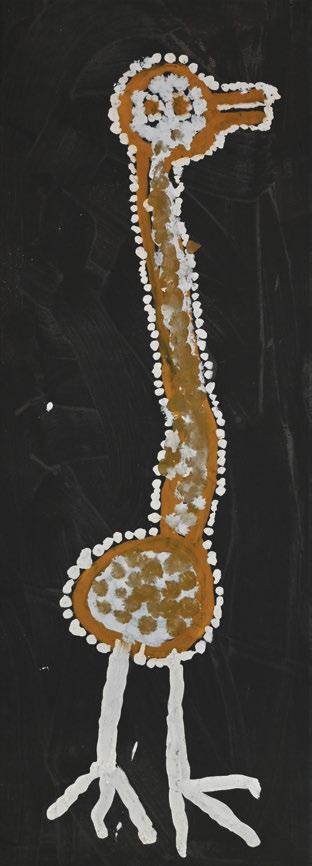
Lulpunda’s Wororra name ‘Anguburra’ refers to the native honey bee that produces the most exquisitely tasting honey. It was a delightful and most fitting name for a woman whose sprightly and spirited engagement with life extended her autumn years beyond all expectation.
Anguburra witnessed and experienced great cultural transformations during her long life, given her presence when Wororra culture was yet to experience the influence and impact of European culture.



The price range listed against each lot reflects the opinion of the art specialists as to what they expect the hammer price each artwork may achieve and is informed by realised prices for comparable artworks in the secondary market. These estimates are intended as a guide only and may sell outside of these ranges. Pre-sale estimates do not include buyer’s premium or other charges where applicable.
The reserve is the minimum price that the vendor will accept for each lot and the lot can not be normally sold lower than this amount. This information is not provided to prospective buyers.
Each artwork will be listed with the known provenance or history of ownership. Non disclosure may indicate that the prior history and provenance was unknown to Cooee Art. All artworks sold through the Cooee Art auctions come with a certificate of authenticity from our auction house. We do endeavour to track down the original certificates from the sellers of the artworks prior to the sale, however, these are sometimes misplaced and are no longer available.
For the full terms and conditions, please visit www.cooeeart.com.au/buy-and-sell/buying-from-a-cooeeart-auction/
The copyright of the artworks listed in this catalogue belong to the artist or their estate and used under licence by Cooee Art. The buyer must not reproduce or otherwise use the images or text without prior written consent. Cooee Art has paid the cost of copyright via the Copyright Agency, 2022.
Some lots consigned for this auction may be subject to the Resale Royalty for Visual Artists Act 2009. Any payments due under the obligations of the Act will be paid by the vendor.
In person – Our auctions are open to the public and held at our premises at 17 Thurlow Street, Redfern. We welcome your attendance if you are in Sydney.
Online – Whether you are just a suburb away or halfway around the world you can bid for all Cooee Art lots in the comfort of your home or office, live and in real-time on our dedicated auction website at auction.cooeeart.com.au or on Invaluable. Please note there is a small service fee charged by Invaluable.
Absentee – For those who prefer not to attend the auction in person or bid online, you can leave an Absentee bid with us by filling in the form found at the back of this catalogue, or whilst at the viewing in our Showroom. By leaving your maximum bid on any lot, the Auctioneer will bid on your behalf up to, but not above, this amount. If the other bidder(s) drop out before your highest bid, you will win the work for the next bidding increment, which may be less than your maximum bid.
Absentee on the website - Here you can leave a bid online for any lot right up until the auction starts at 7pm.You will be notified if someone outbids you before the auction. If you are outbid by someone in the room or on the phones during the auction, you will miss out. A good strategy is to leave the highest bid you are willing to buy the artwork for and the computer will keep bidding on your behalf up to that amount.Your maximum amount is confidential, so you may win the lot for a much lower amount.
Telephone - By using this option, you can bid on any lot from the comfort of your home, anywhere in the world. You will be called 2 - 3 lots before your selected lot comes up and one of our staff will act on your behalf, being your eyes, ears, and spokesperson for the evening. It is also advisable to leave a Cover Bid (which acts the same way as an Absentee Bid) so that if we are unable to reach you on the night, the person calling can then step in and bid for you up to your Cover Bid amount.
Bidding typically opens below the listed pre-sale estimate and proceeds in the following increments (however it is at the discretion of the auctioneer, and may vary)
$0 - $1,000 by $50
$1,000 - $2,000 by $100
$2,000 - $5,000 by $200
$5,000 - $10,000 by $500
$10,000 - $20,000 by $1000
$20,000 - $50,000 by $2,000
$50,000 - $100,000 by $5,000
$100,000 - $200,000 by $10,000
$200,000 - $500,000 by $20,000
$500,000 - $1,000,000 by $50,000
$1,000,000 and over by $100,000
A buyer’s premium of 25% (including GST) is added to the hammer price of each lot. The hammer price is the last bid that is accepted by the auctioneer.
The fall of the auctioneer’s hammer indicates the bid has been accepted and the work is sold, the buyer assumes full responsibility for the lot from this time.
The day after the sale, the Post-Sale team will send you an Invoice. The final amount due will include the hammer price, the 25% buyer’s premium, and the service fee charged by Invaluable if you are using their services. Electronic Bank Transfer is the simplest payment method and your invoice will include our bank details. A 2% surcharge applies to Visa, MasterCard, and AMEX payments. Alternatively, payment may be made by cheque, cash or eftpos. Please note: payments made by cheque are subject to a 5-day clearance before goods can be collected.
If buyer is an Australian resident, a 10% GST is included in the following instances
a.In the final hammer price when buying from a GST registered vendor
b. When additional fees are required i.e. shipping
c. Buyers Premium
All collection notifications, shipping options, and requests for carrier recommendations are to be emailed to our Auction Administration email address auction@cooeeart. com.au. Cooee Art will endeavour to supply you with the best and most cost effective option for shipping your artwork to you, but you are not obliged to use this service and may organise your own transport options. Please inform us as soon as possible of your preferred method. Proof of identification is required upon collection. Lots not collected within 7 days of the sale may incur costs associated with external storage and freight. Should you request that Cooee Art wrap and/or pack your goods and arrange postage of your items for you, a fee will apply, and whilst all care is taken, we accept no responsibility for any damage.
(Mr/Mrs/Ms/Miss) Name (please print)
Business name
Address
City State Postcode
Telephone/Mobile Email
Indigenous Fine Art Auction Catalogue (single issue) $35* *price includes G.S.T. postage and handling. Additional
(Mr/Mrs/Ms/Miss) Name (please print)
Business name
Address
City State Postcode
Telephone/Mobile Email
Subscription
Name on card
Card number
SALE NO.: 11 INDIGENOUS FINE ART AUCTION
11 OCTOBER 2022, 7:00PM AEDT
LOTS 1 - 103 17 THURLOW STREET REDFERN NSW 2016
please email or post this completed form to:
COOEE ART 17 THURLOW STREET REDFERN NSW 2016
tel: +61 (02) 9300 9533 auction@cooeeart.com.au
date
Country
orders Tax invoice required
please email or post this completed form to:
COOEE ART 17 THURLOW STREET REDFERN NSW 2016
tel: +61 (02) 9300 9533 auction@cooeeart.com.au
SALE NO.: 11
INDIGENOUS FINE ART AUCTION
11 OCTOBER 2022, 7:00PM AEDT LOTS 1 - 103 17 THURLOW STREET REDFERN NSW 2016
*Not including buyer’s premium or GST (where applicable). bids are made in Australian dollars.
bids must be received a minimum of twenty-four hours prior to auction. All telephone bids received will be confirmed by phone or email. In the event that confirmation is not received, please resubmit or contact our office.
refer to the Buyers Terms & Conditions of Auction found at www.cooeeart.com.au/buying-from-acooee-art-auctions for information regarding sales.
By completing this form, I authorise COOEE ART to contact me by telephone on the contact number(s) nominated. I understand it is my responsibility to enquire whether any Sale-Room Notices relate to any lot on which I intend to bid. I also understand that should my bid(s) be successful, a buyer’s premium of 25% (inclusive of GST), will be added to the final hammer price.
I accept that COOEE ART provides this complimentary service as a courtesy to its clients, that there are inherent risks to telephone bidding, and I will not hold COOEE ART responsible for any error.
A member of the Cooee Art team will contact you a few minutes before your indicated desired lots.The Cover Bid Price will be used should a member of staff not be able to reach you.
Should your final bid be successful, you will be obliged to pay the final bid price plus buyer’s premium of 25% (incl of GST) of the final bid amount.
email or post this completed form to:
COOEE ART
17 THURLOW STREET REDFERN NSW 2016
tel: +61 (02) 9300 9533 auction@cooeeart.com.au
SALE NO.: 11
INDIGENOUS FINE ART AUCTION
11 OCTOBER 2022, 7:00PM AEDT
LOTS 1 - 103
17 THURLOW STREET REDFERN NSW 2016
*Not including buyer’s premium or GST (where applicable). bids are made in Australian dollars. Absentee bids must be received by 2pm the pay of the auction. All absentee bids received will be confirmed by phone or email. In the event that confirmation is not received, please resubmit or contact our office.
refer to the Buyers Terms & Conditions of Auction found at www.cooeeart.com.au/buying-from-acooee-art-auctions for information regarding sales.
By completing this form, absentee bidders request and authorise COOEE ART to place the following bids acting as agent on their behalf up to and including the maximum bid specified. Lots will be bought at the lowest possible bid authorised by the bidder in absentia.
I understand it is my responsibility to enquire whether any Sale-Room Notices relate to any lot on which I intend to bid. I also understand that should my bid(s) be successful, a buyer’s premium of 25% (inclusive of GST), will be added to the final hammer price.
COOEE ART provides this complimentary service as a courtesy to clients and does not accept liability for errors and omissions in the execution of absentee bids. Should your bid be successful, you will be obliged to pay the final bid price plus buyer’s premium of 25% (incl of GST) of the final bid price.
please email or post this completed form to:
COOEE ART
17 THURLOW STREET REDFERN NSW 2016
+61 (02) 9300 9533 auction@cooeeart.com.au
RECEIVED BY
DATE TIME
BIDDER NO.
Lin Onus/Copyright
Makinti Napanangka/Copyright
Richard Bell/Copyright Agency
Minnie Pwerle/Copyright Agency
Mirdidingkingathi Juwarnda Sally Gabori/Copyright Agency
Emily Kame Kngwarreye/Copyright Agency
© Albert Namatjira/Copyright Agency

Queenie McKenzie Nakara/Copyright Agency
Emily Kame Kngwarreye/Copyright Agency
Bill Tjapaltjarri Whiskey/Copyright Agency
John Mawurndjul/Copyright
Rover Thomas Joolama/Copyright
Brook Andrew/Copyright Agency
Destiny Deacon/Copyright Agency
Lin Onus/Copyright Agency
Johnny Mosquito Tjapangarti/Copyright Agency
© Patsy Anguburra Lulpunda/Copyright Agency
© Jack Dale/Copyright Agency
Freddie Timms/Copyright Agency
Charlie Numbulmoore/Copyright Agency
Paddy Jampin Jaminji/Copyright Agency
Freddie Timms/Copyright Agency
© Mick Namarari Tjapaltjarri/Copyright Agency
Clifford Possum Tjapaltjarri/Copyright Agency
Ronnie Tjampitjinpa/Copyright Agency
© Warlimpirrnga Tjapaltjarri/Copyright Agency
© Ronnie Tjampitjinpa/Copyright Agency
© George Ward Tjungarrayi/Copyright Agency
© George Milpurrurru/Copyright Agency
Jack Wunuwun/Copyright Agency
Datjirri 2 Wunuŋgmurra/Copyright
Minnie Pwerle/Copyright
Dorothy Robinson Napangardi/Copyright
Gloria Petyarre/Copyright
Emily Kame Kngwarreye/Copyright
Warlimpirrnga Tjapaltjarri/Copyright
Turkey Tolson Tjupurrula/Copyright
Naata Nungurrayi/Copyright
Nyumiti Burton
Joylene Presley/Copyright
Tommy Watson/Copyright
Naata Nungurrayi/Copyright
McKenzie Nakara/Copyright
Kame Kngwarreye/Copyright
Regina Wilson/Copyright
Watson/Copyright
Pwerle/Copyright
Ngal/Copyright
Kame Kngwarreye/Copyright
Johnny Warangkula
Agency
Nyurapayia Nampitjinpa (Mrs Bennett)/Copyright Agency
Warlimpirrnga Tjapaltjarri/Copyright Agency
© Jean Apuatimi Baptiste/Copyright Agency
© Kitty Kantilla/Copyright Agency
© Cory Surprise/Copyright Agency
© Eubena Nampitjin/Copyright Agency
Elizabeth Nyumi Nungurrayi/Copyright Agency
© Boxer Milner/Copyright Agency
© Paddy Wainburranga Fordham/Copyright Agency
© Peg Leg Tjampitjinpa/Copyright Agency
© Dickie Minyintiri/Copyright Agency
© Mawukura (Mulgra) Jimmy Nerrimah/Copyright Agency
© Tjumpo Tjapanangka/Copyright Agency
© Dickie Minyintiri/Copyright Agency
© Charlie Taruwa Tjungurrayi/Copyright Agency
© John Kiparra Tjakamarra/Copyright Agency
© Judy Napangardi Watson/Copyright Agency
© Alma Webou/Copyright Agency
© Jan Billycan/Copyright Agency
© Keith Stevens/Copyright Agency
© Timmy Payungka Tjapangati/Copyright Agency
© Julie Nangala Robertson/Copyright Agency
© Dorothy Robinson Napangardi/Copyright Agency
© Abie Kemarre Loy/Copyright Agency
© Minnie, Molly, Emily & Galya Pwerle - The Four Sisters/Copyright Agency
© Tiger Palpatja/Copyright Agency
© Johnny Yungut Tjupurrula/Copyright Agency
© Jan Billycan/Copyright Agency
© Minnie Pwerle/Copyright Agency
© Mirdidingkingathi Juwarnda Sally Gabori/Copyright Agency
© Patsy Anguburra Lulpunda/Copyright Agency
